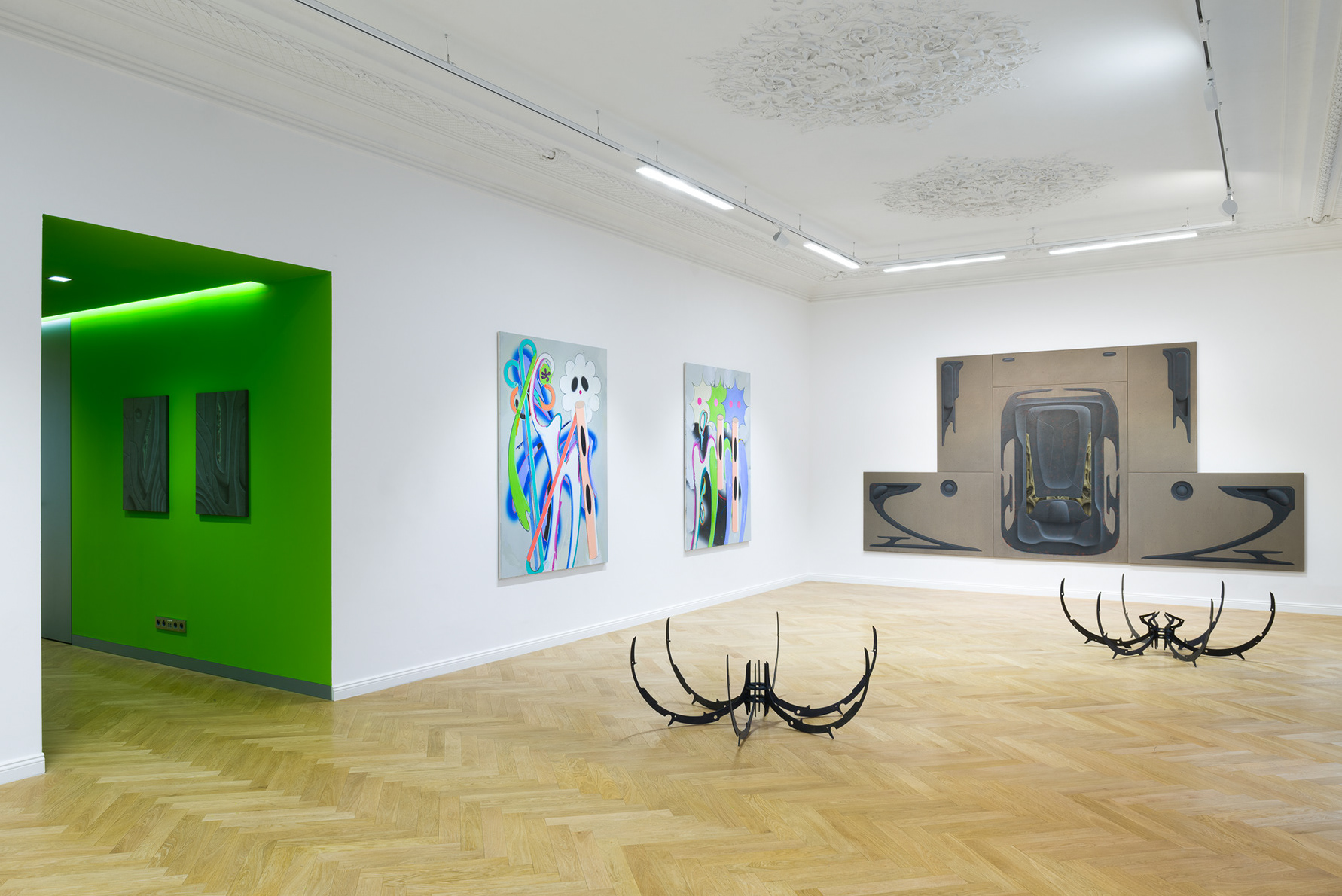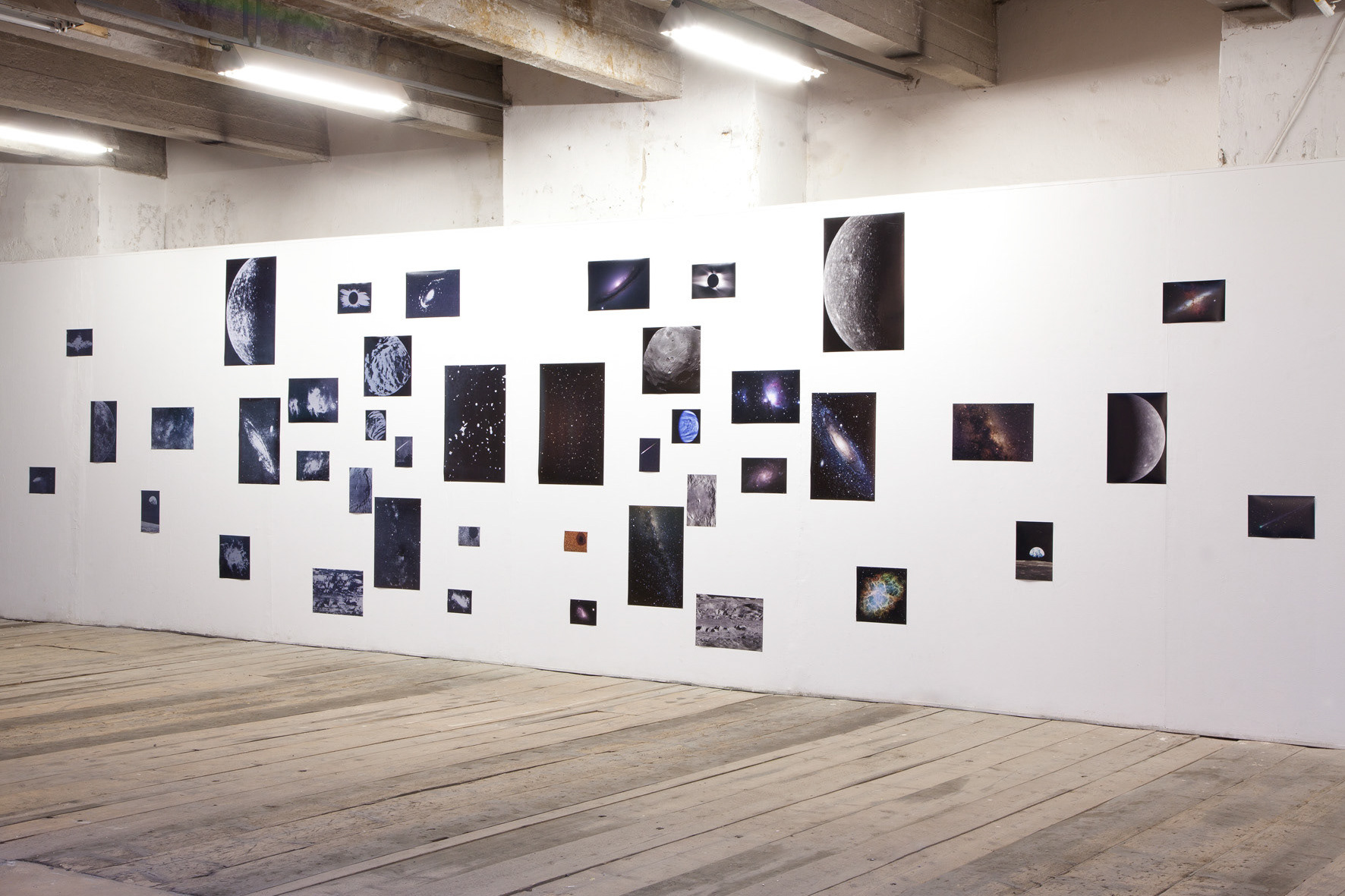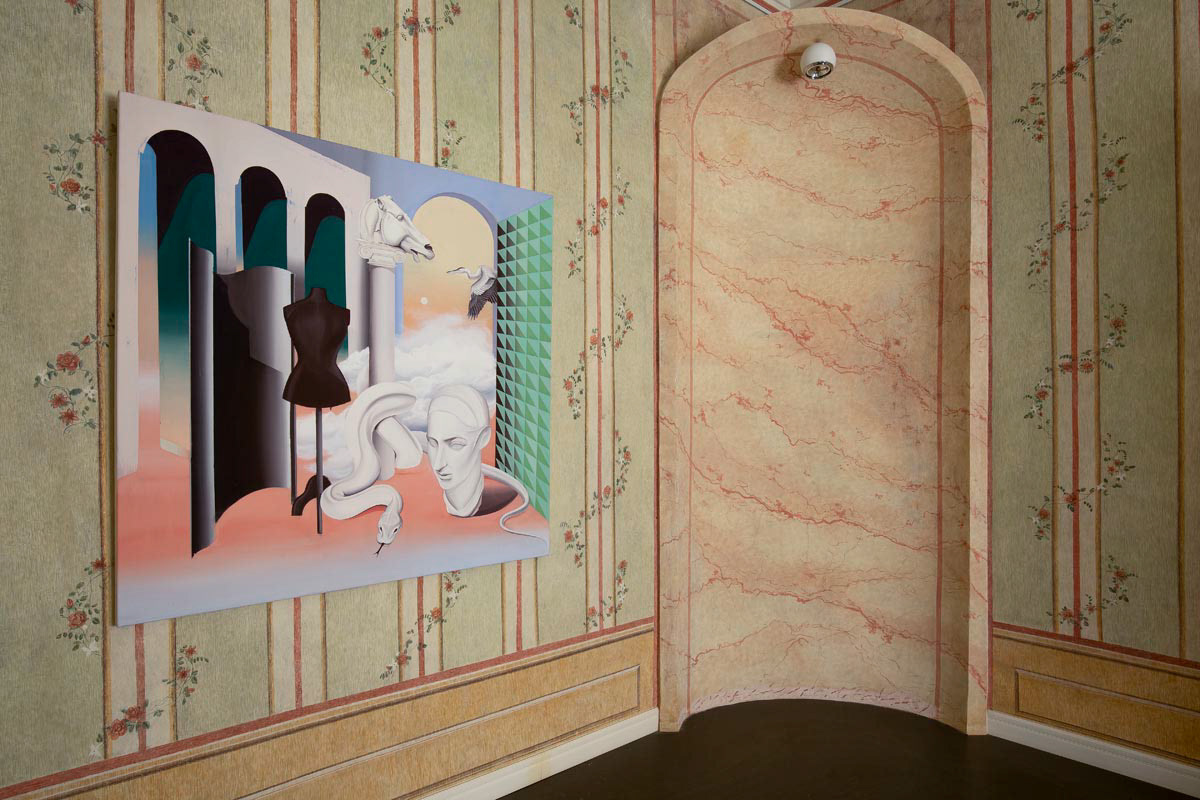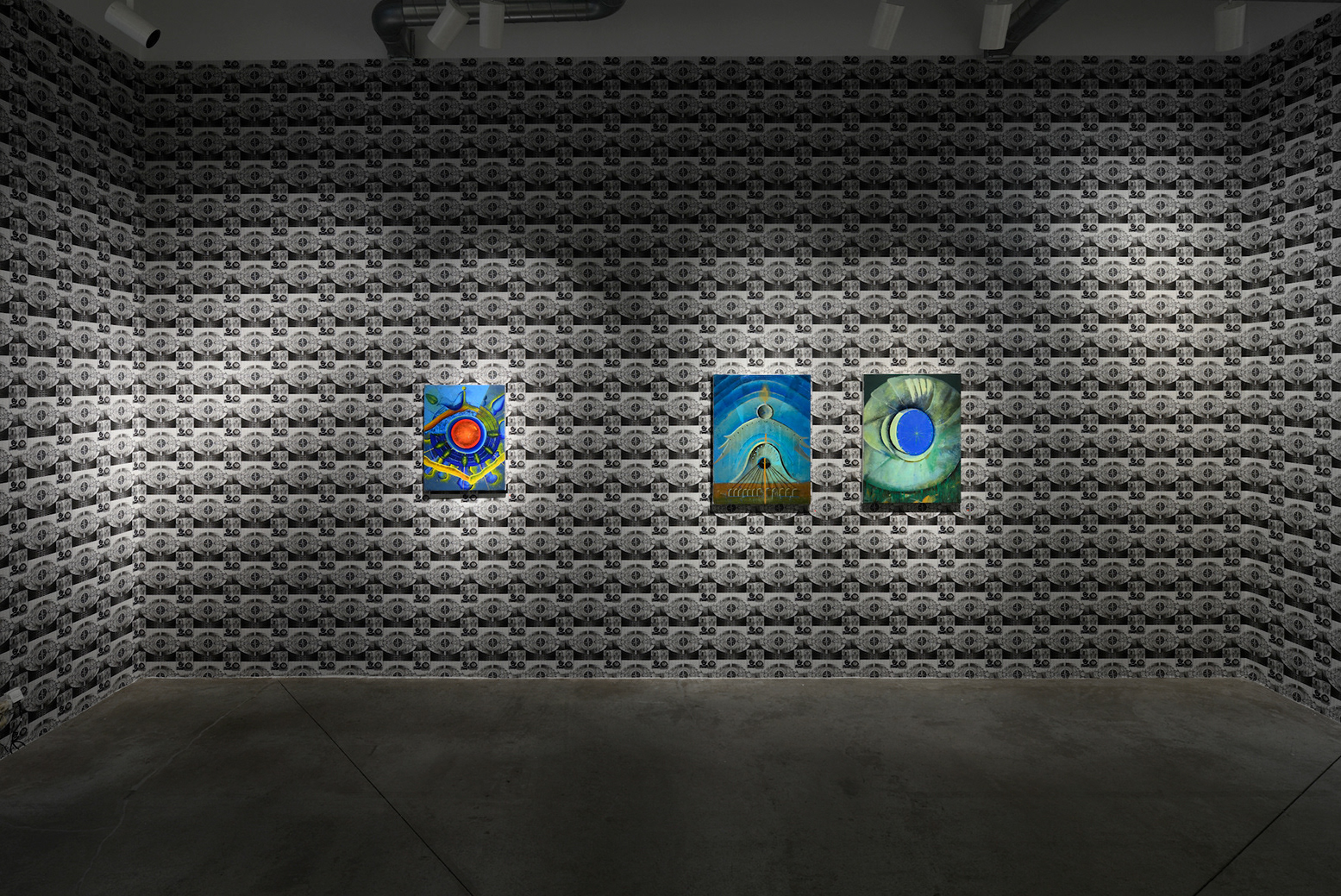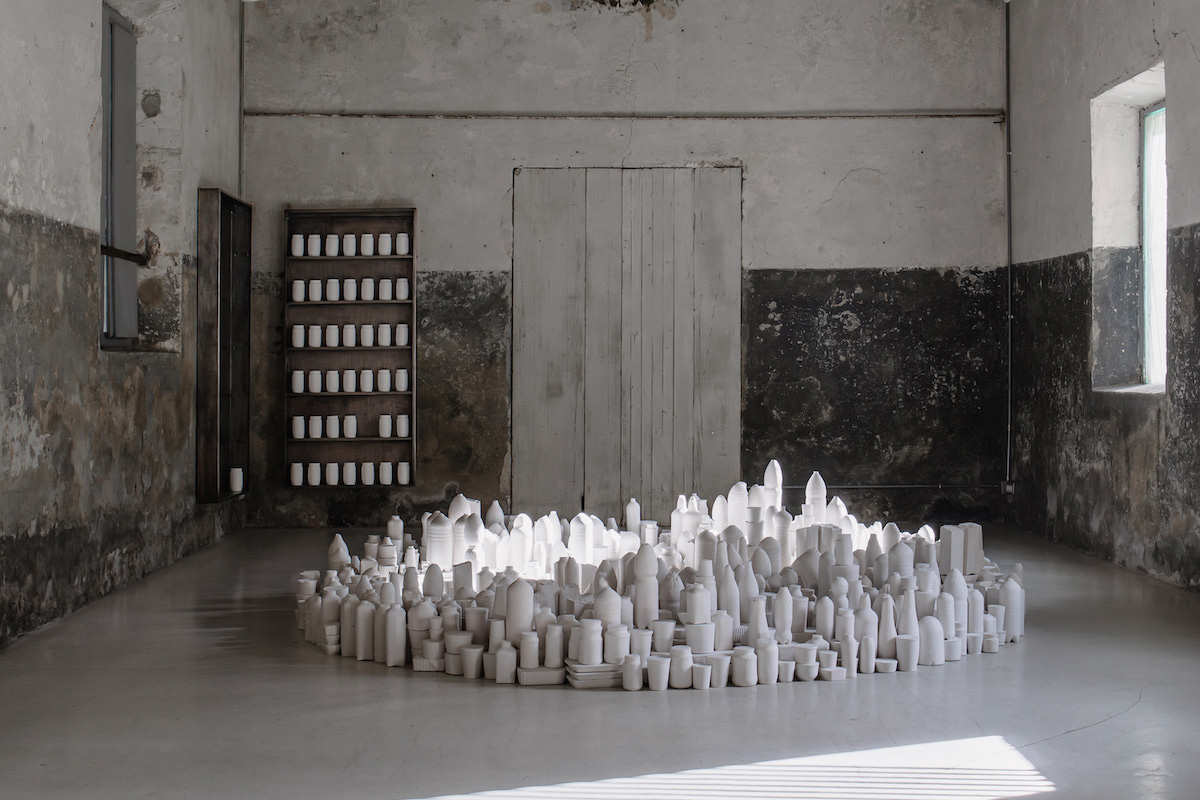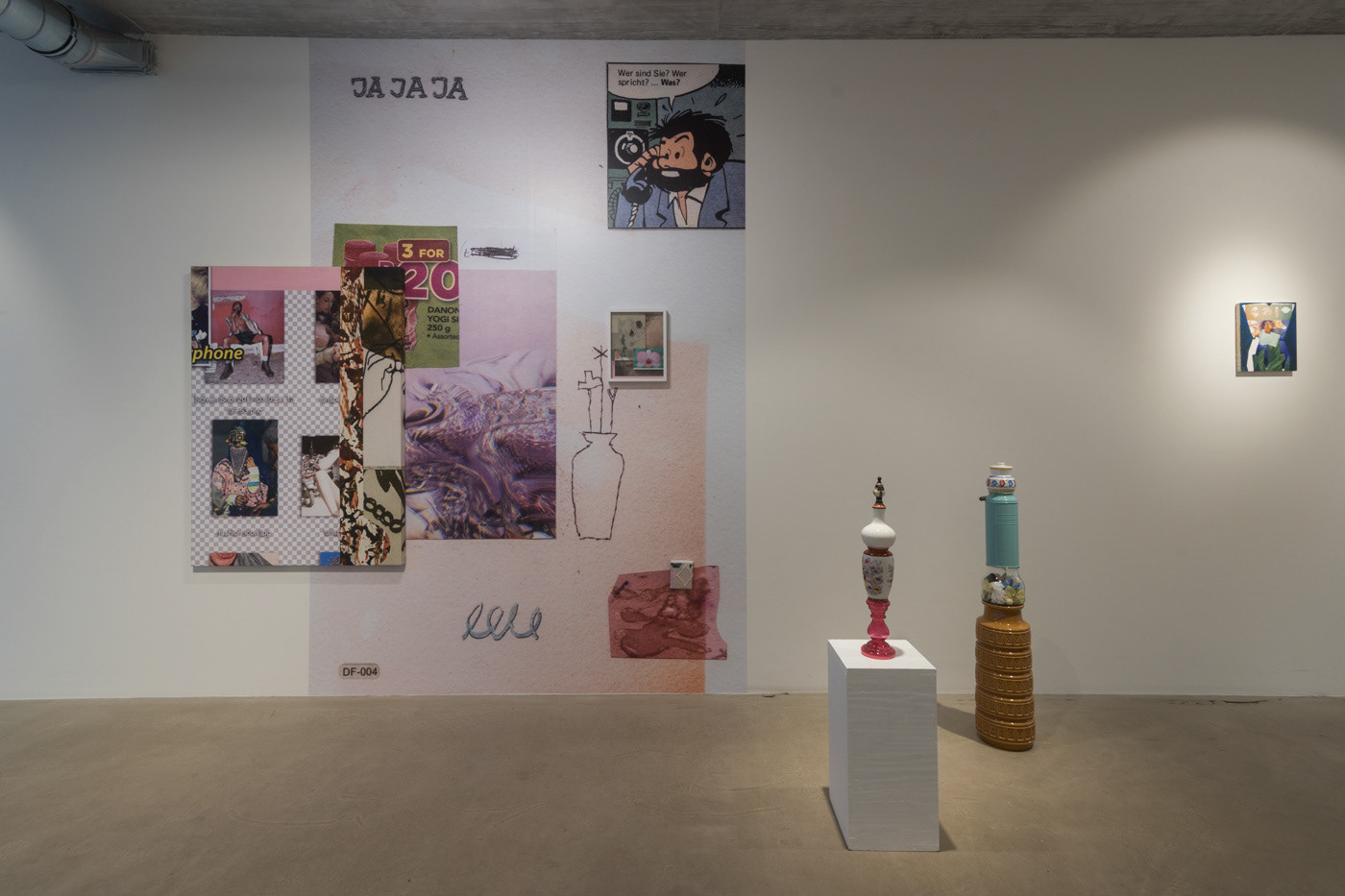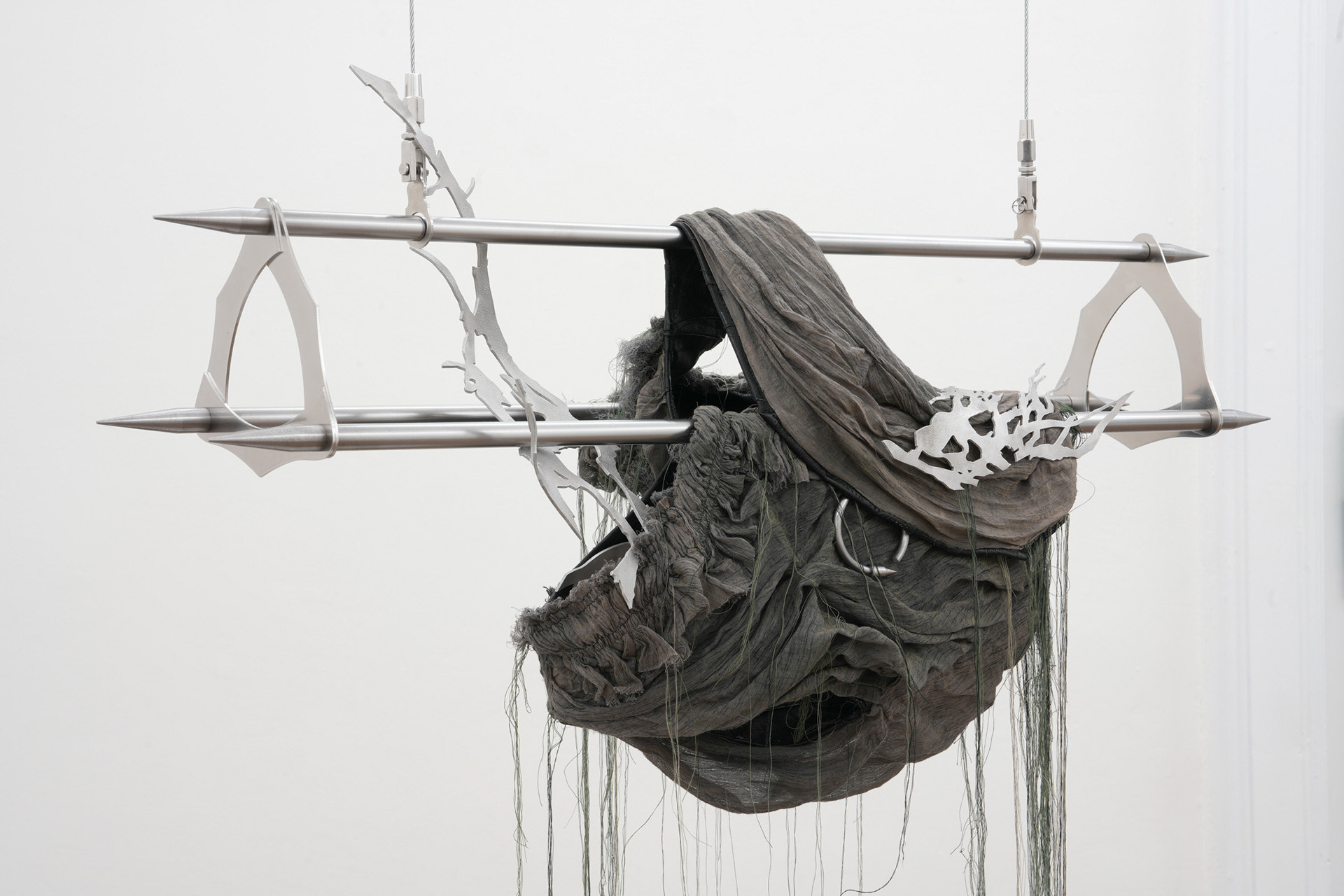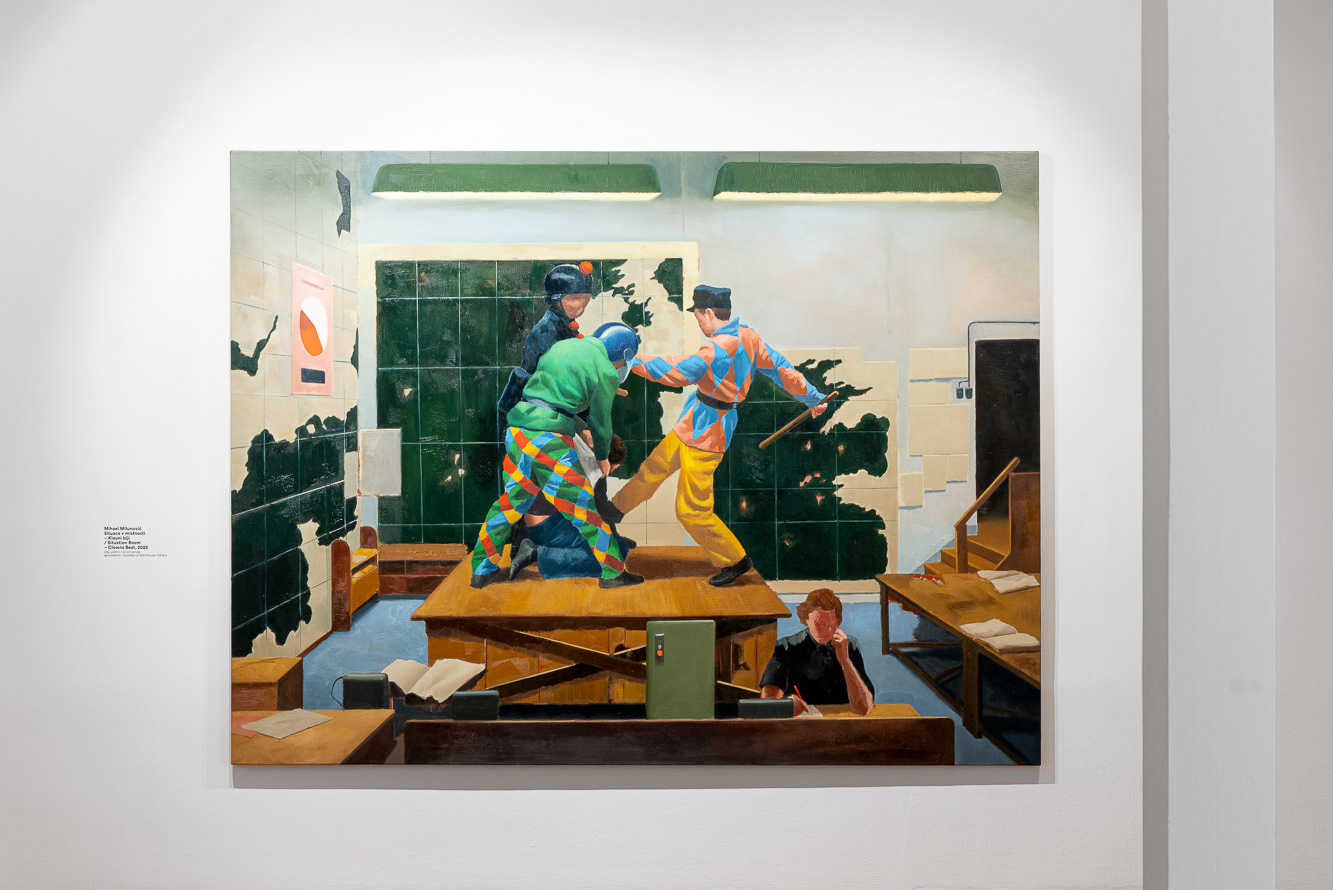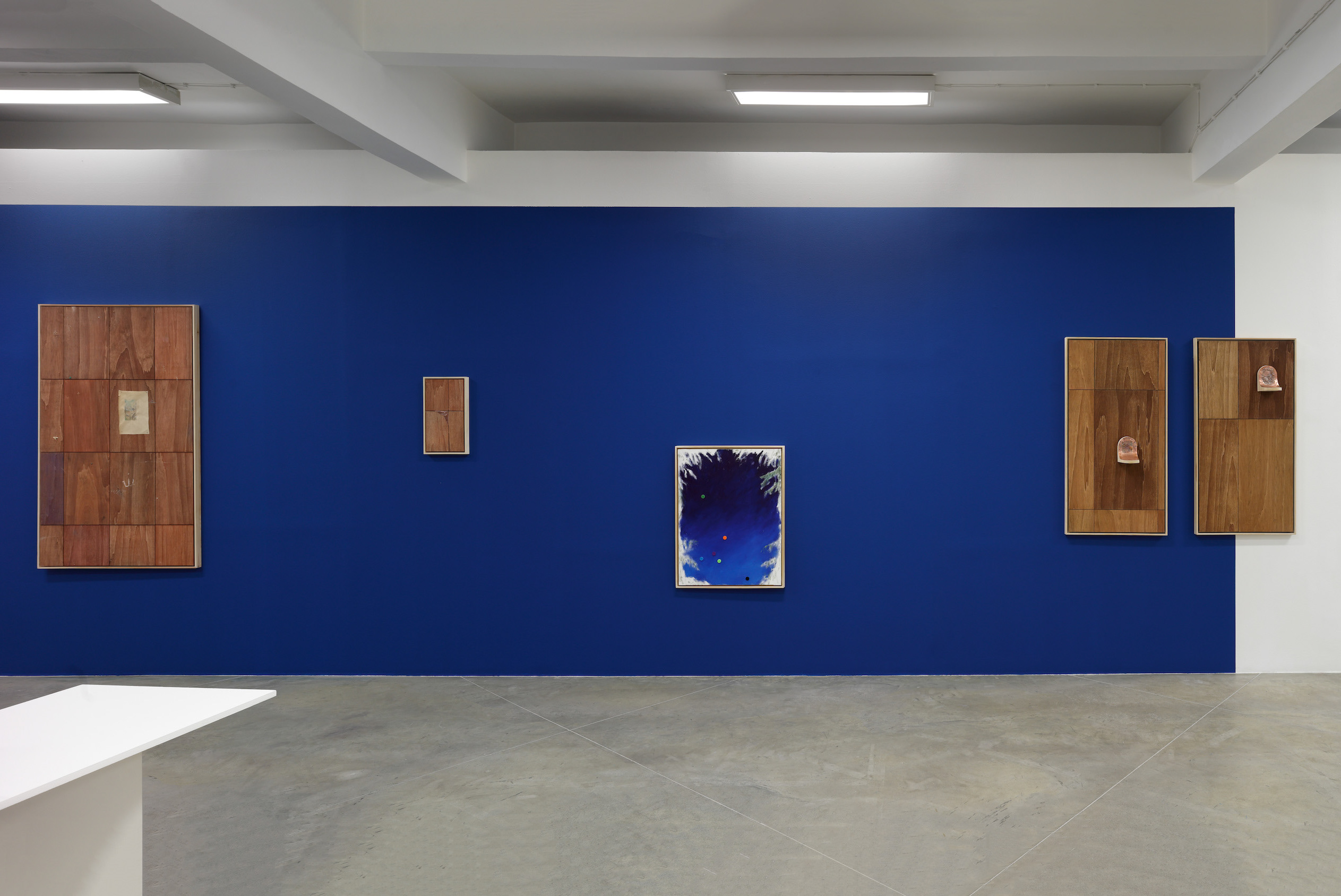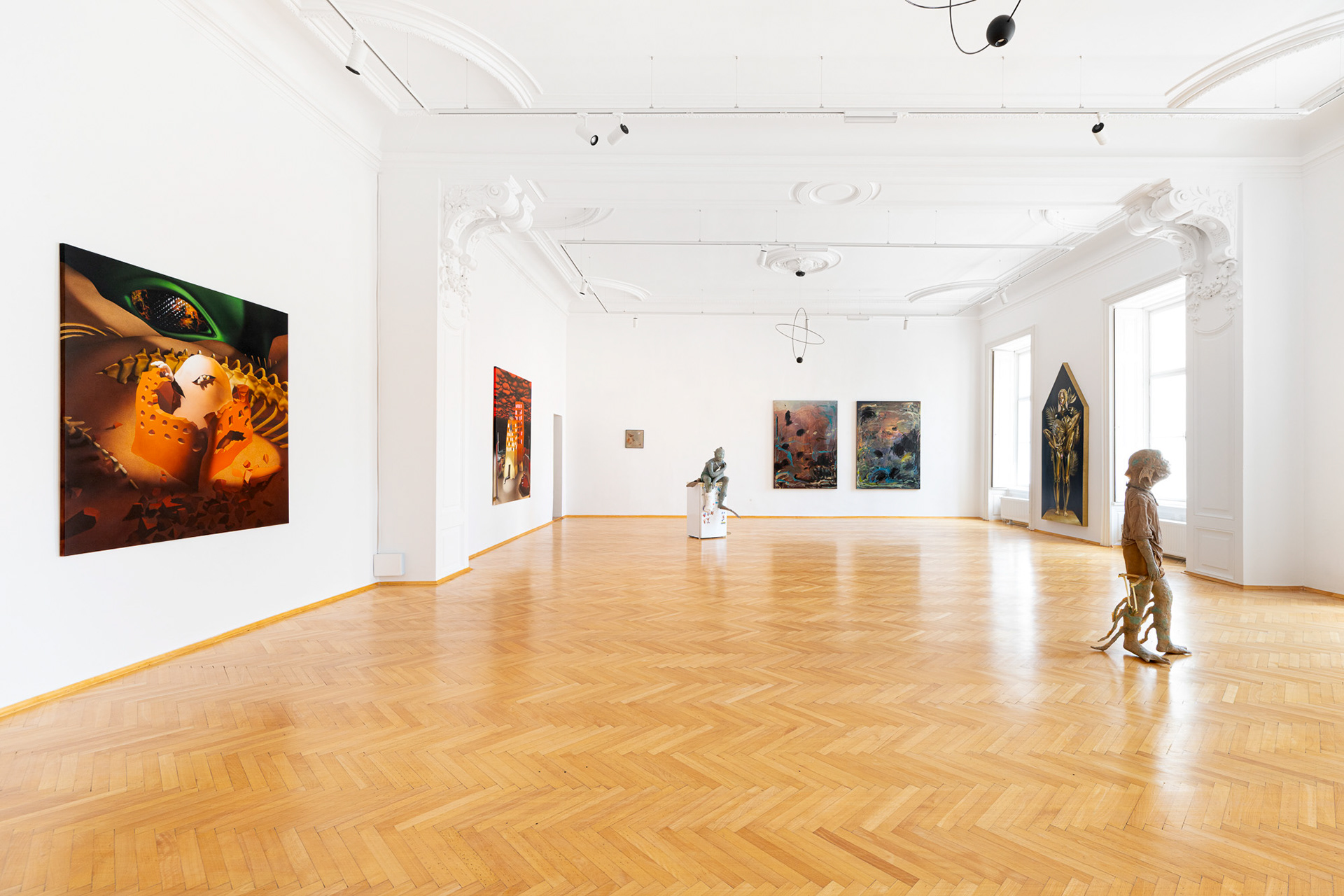
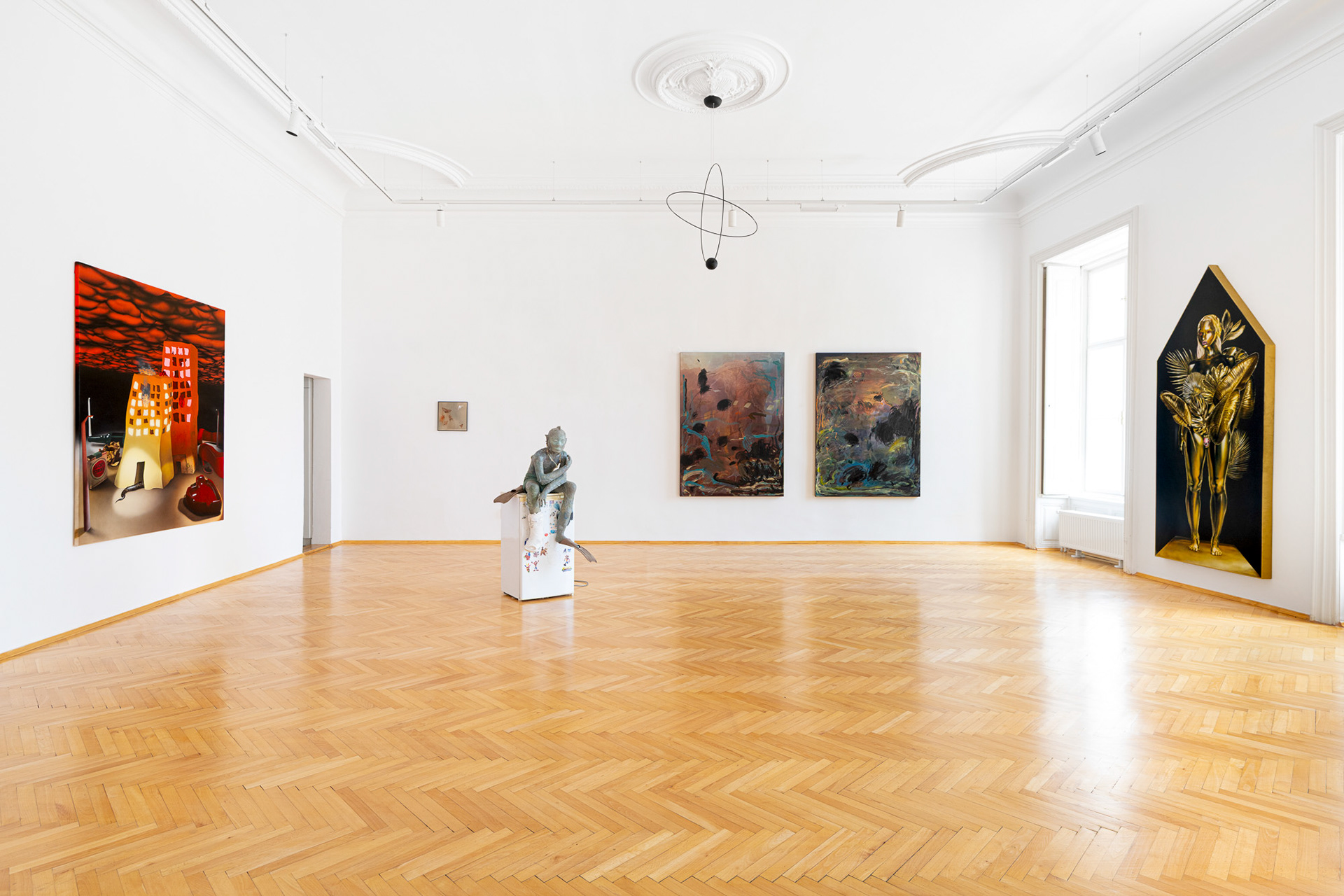
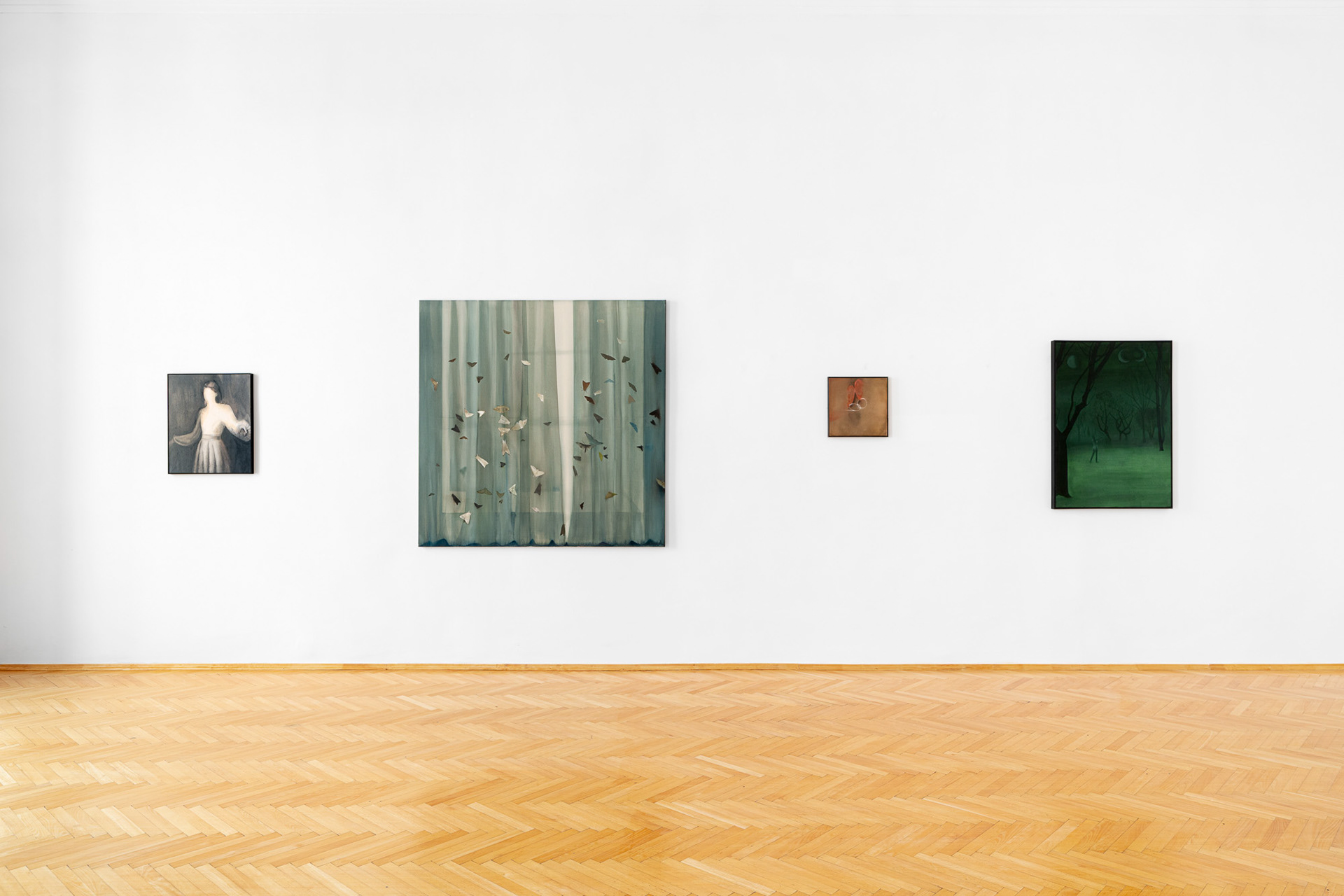
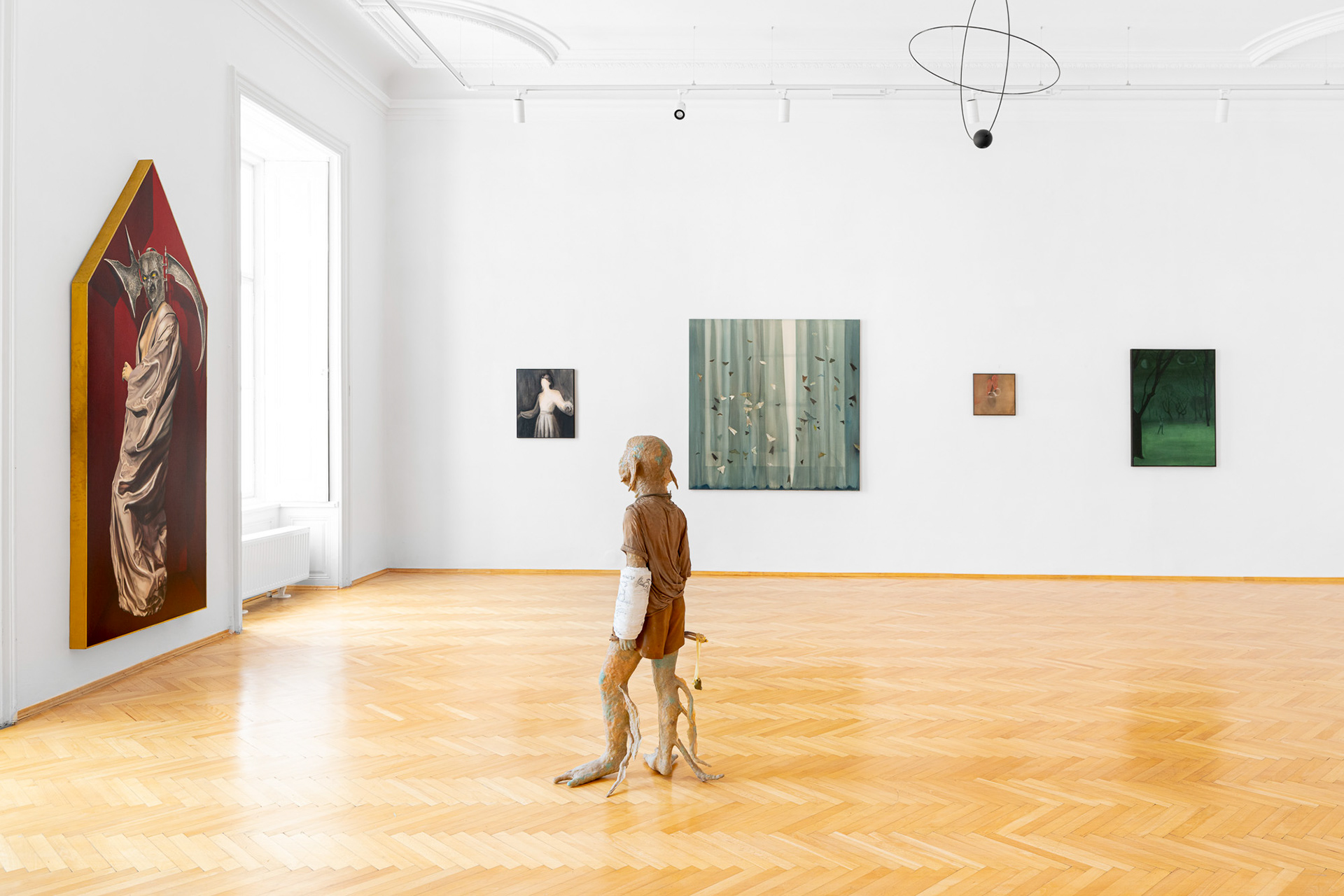
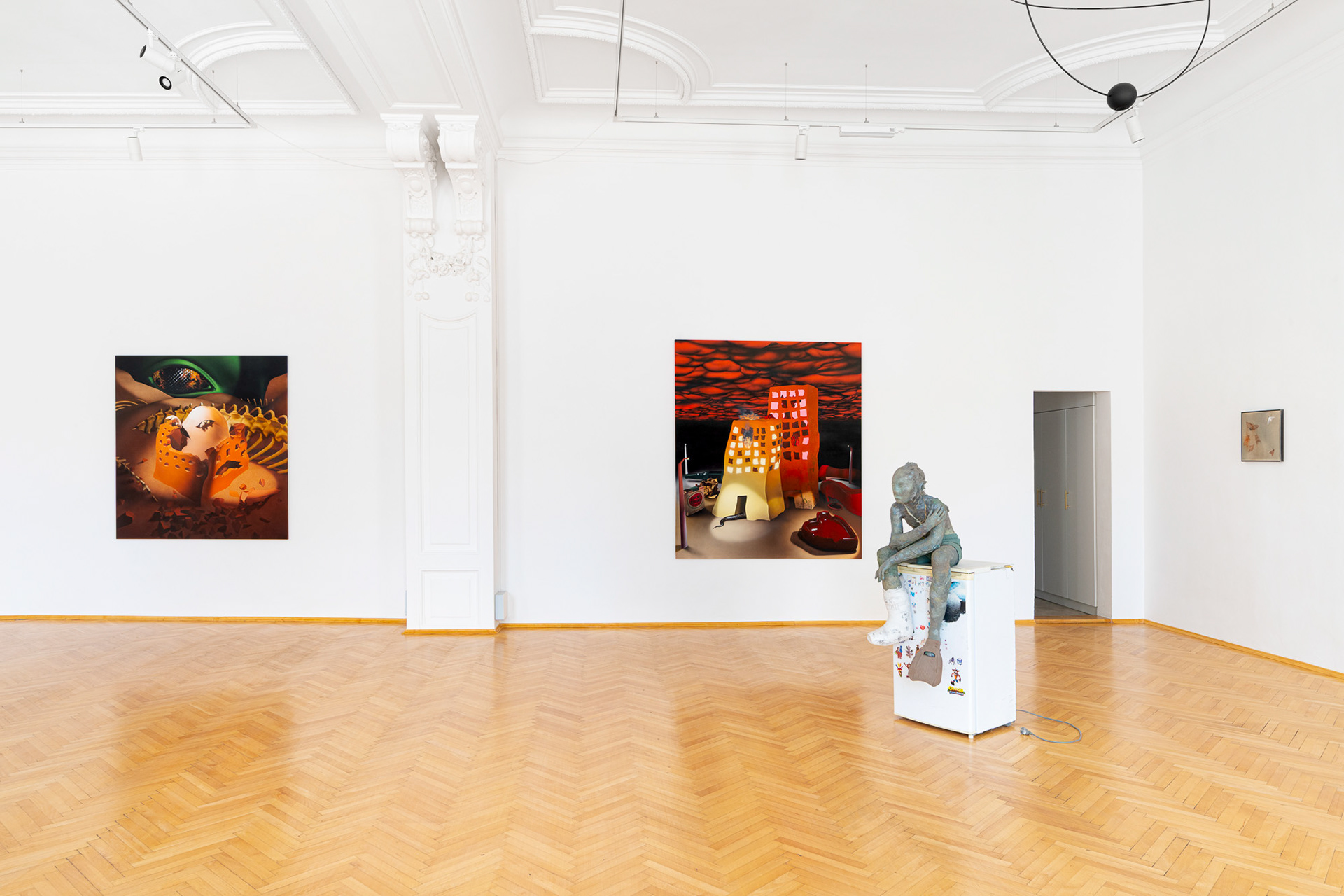
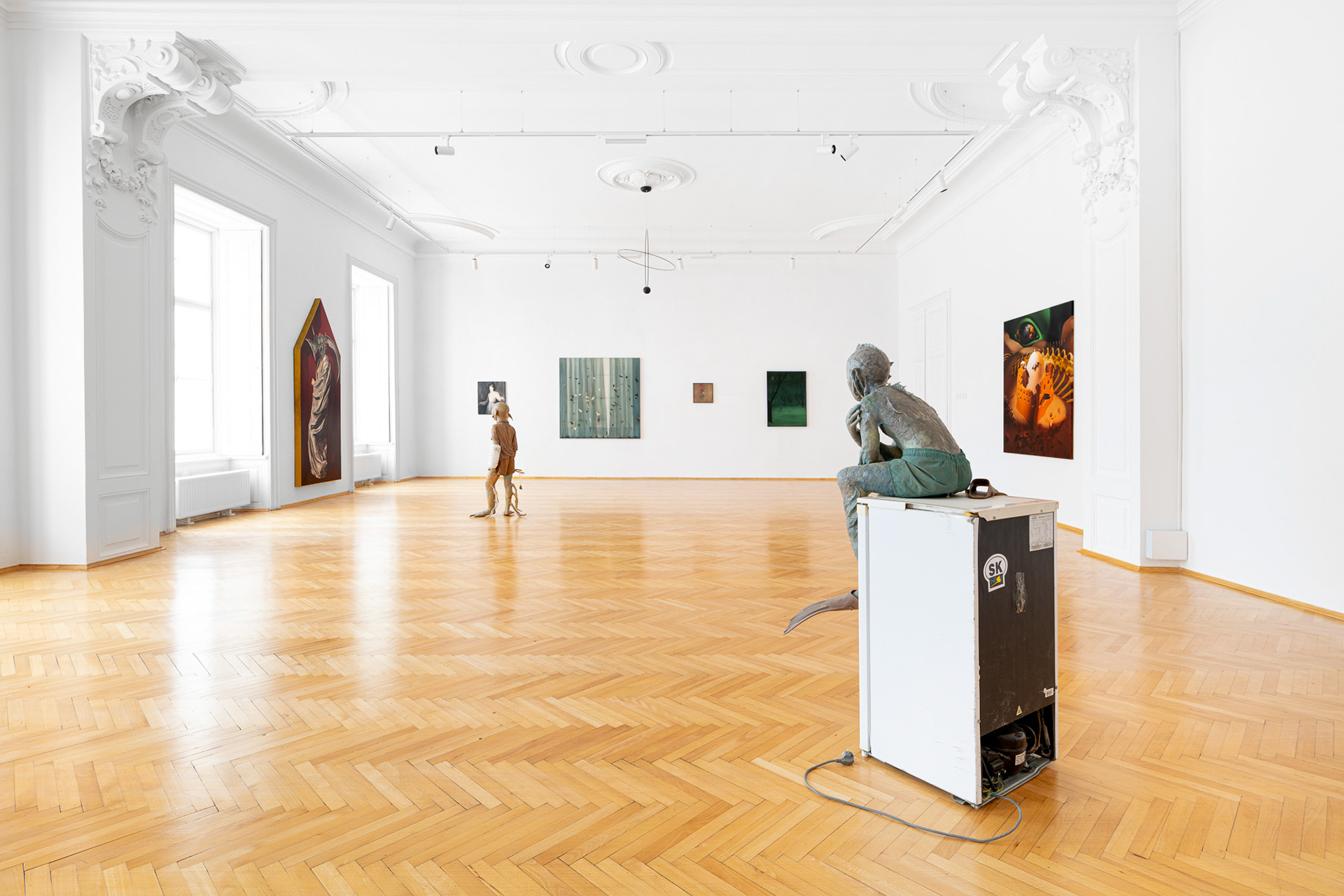
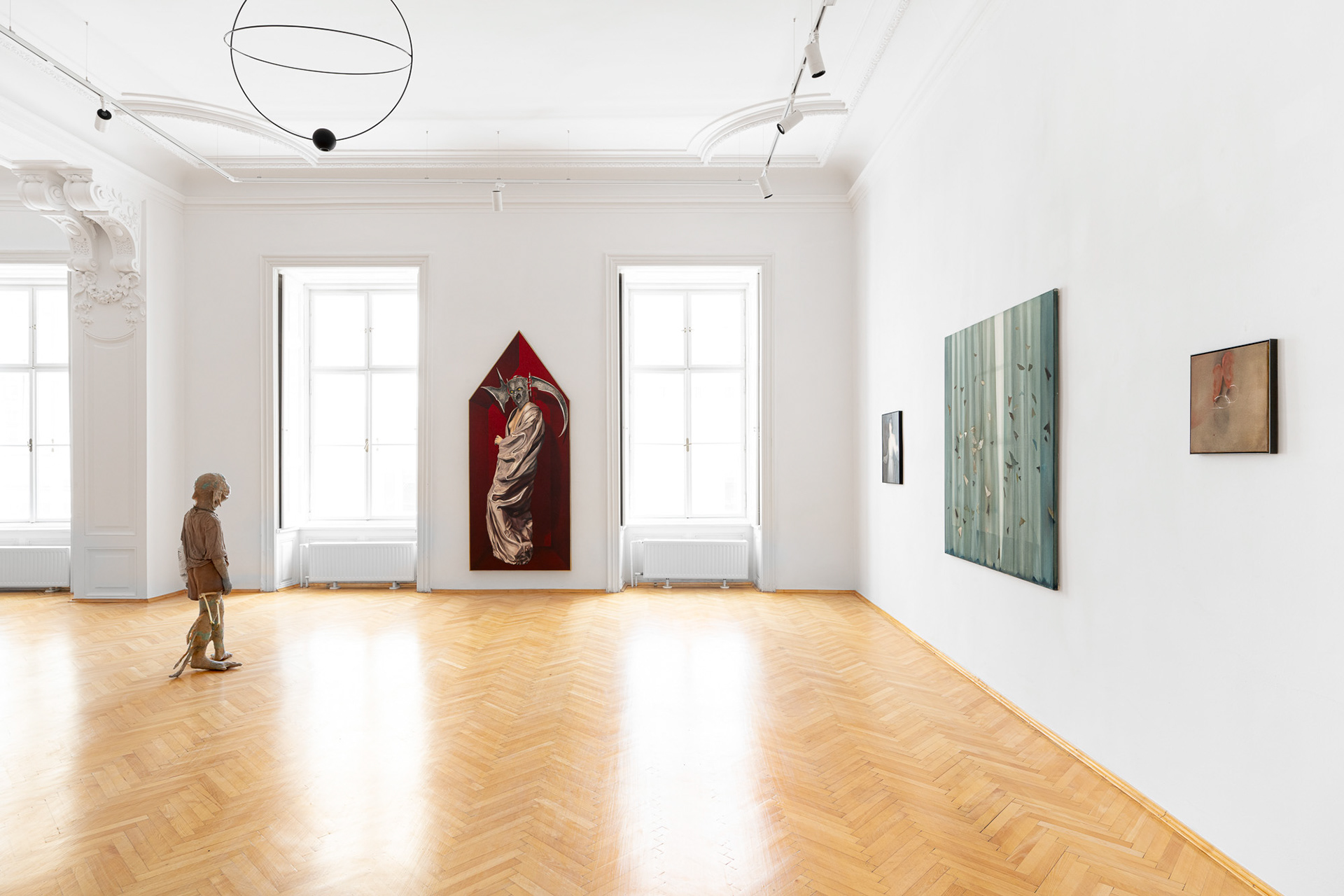
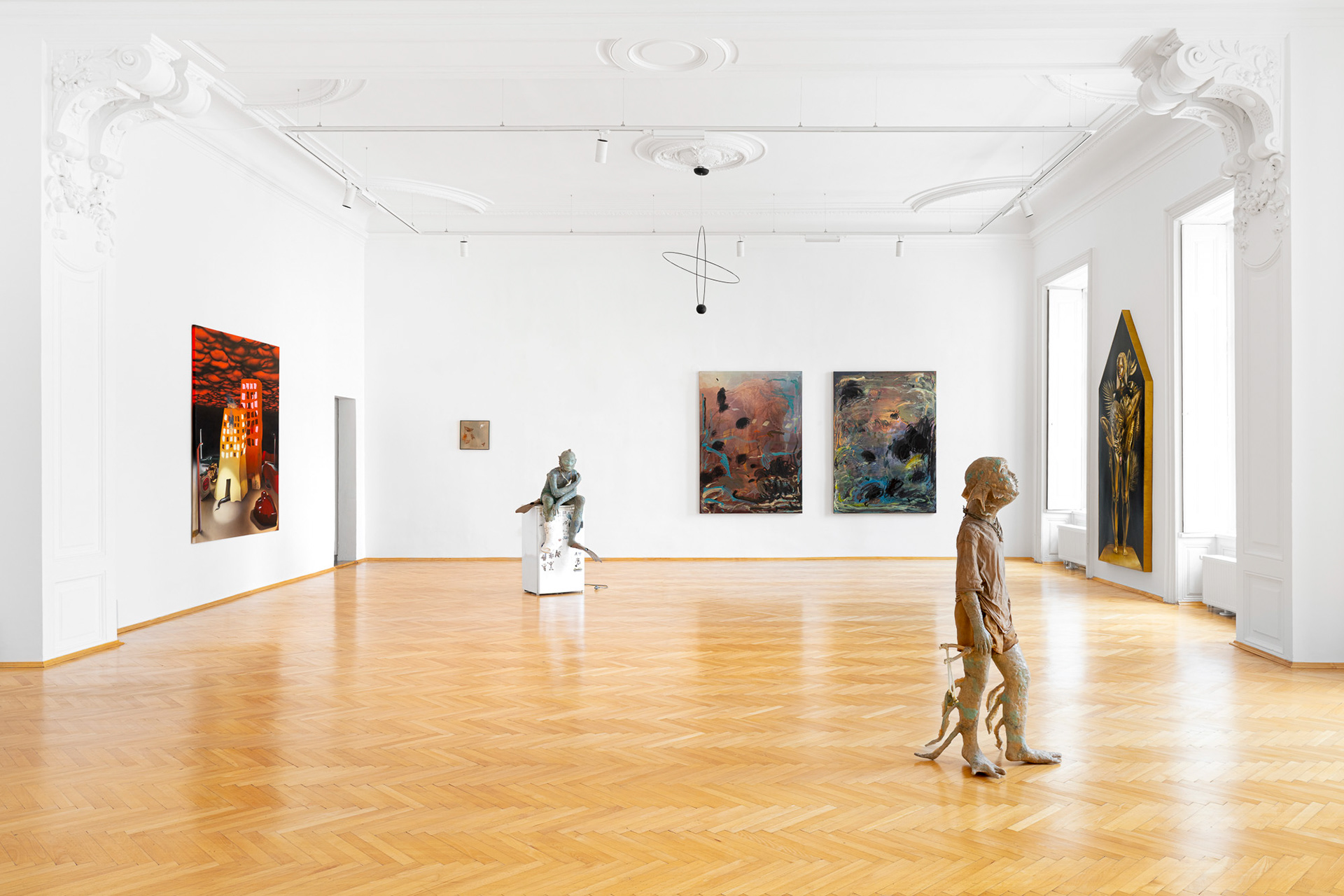
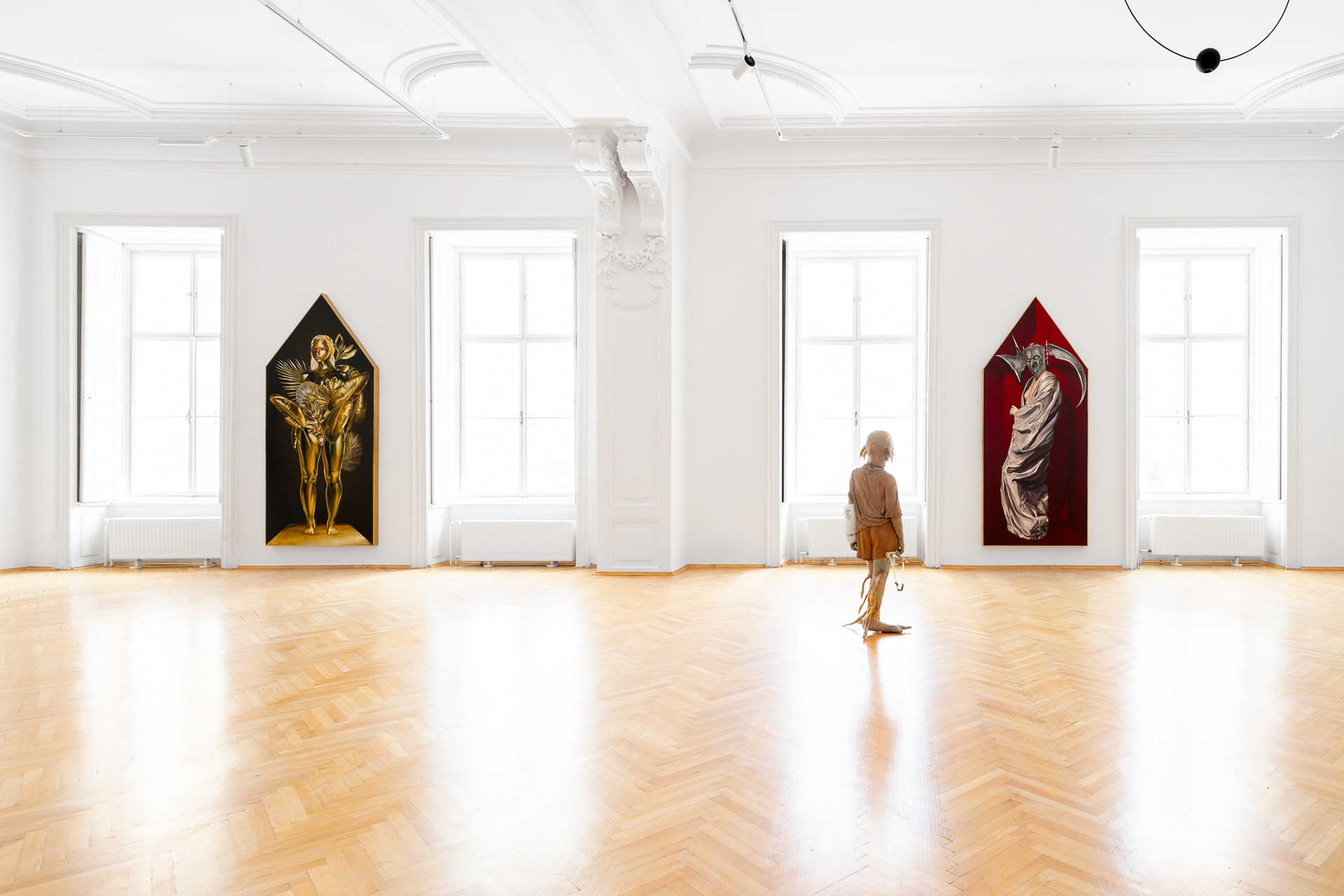
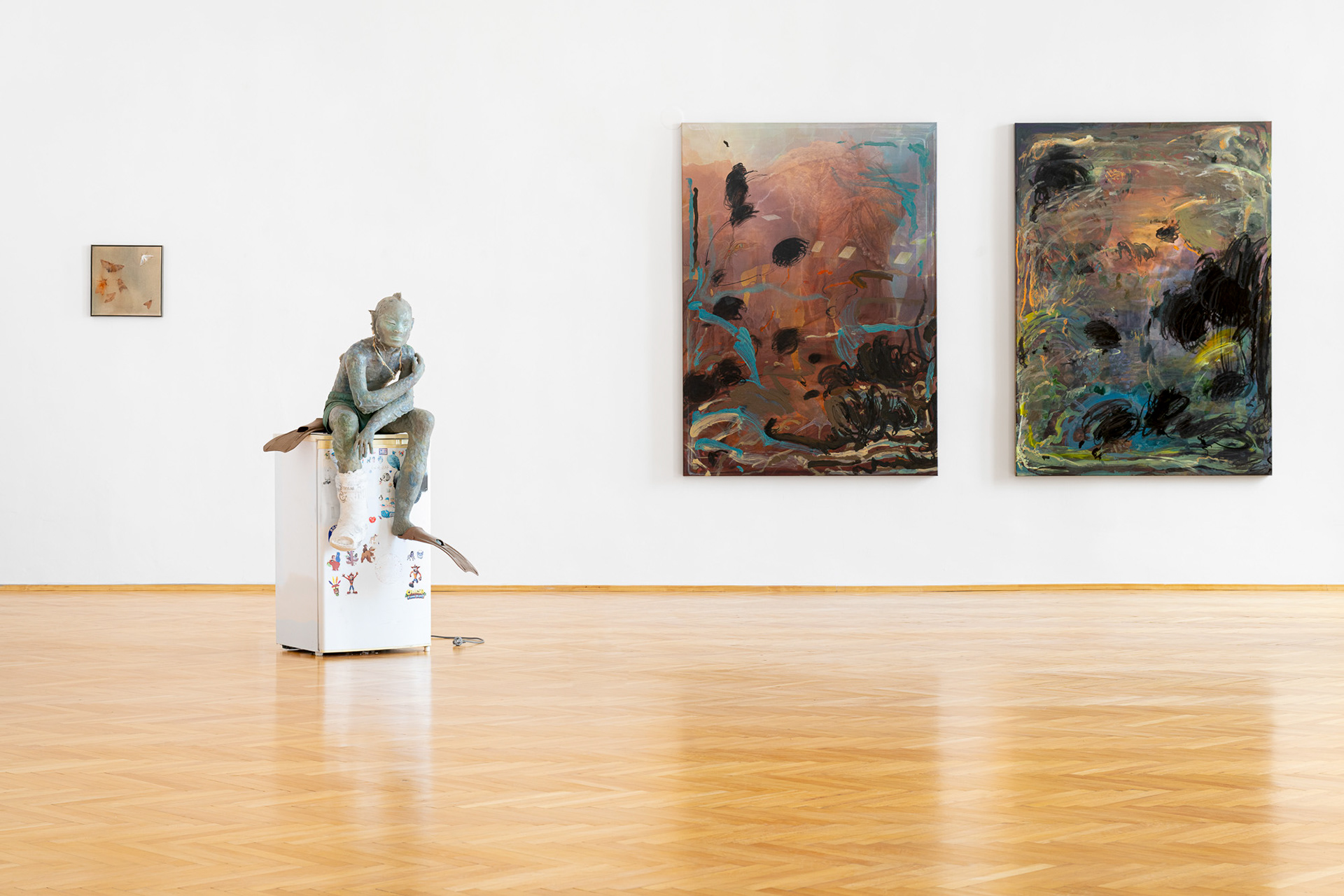
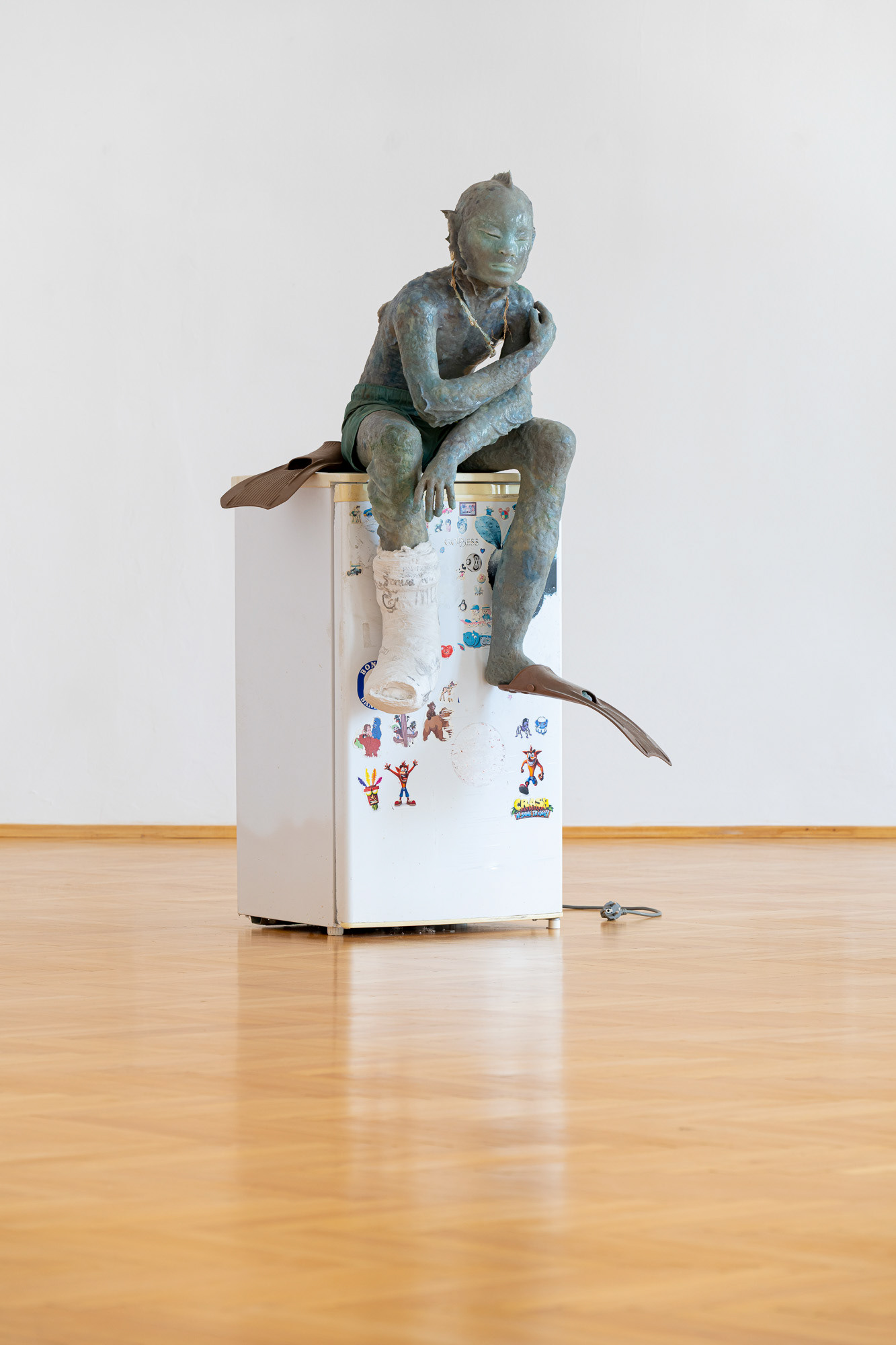
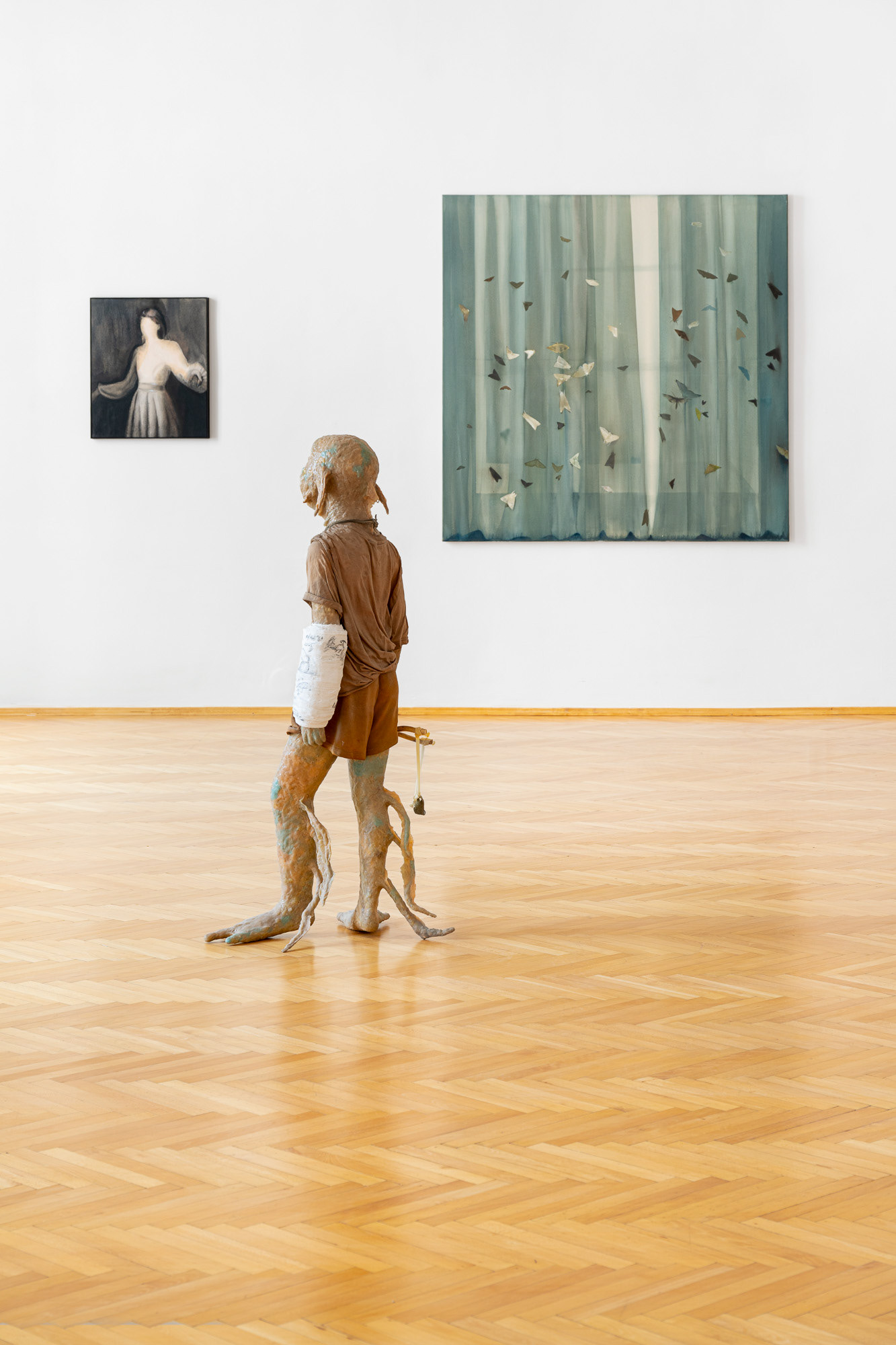
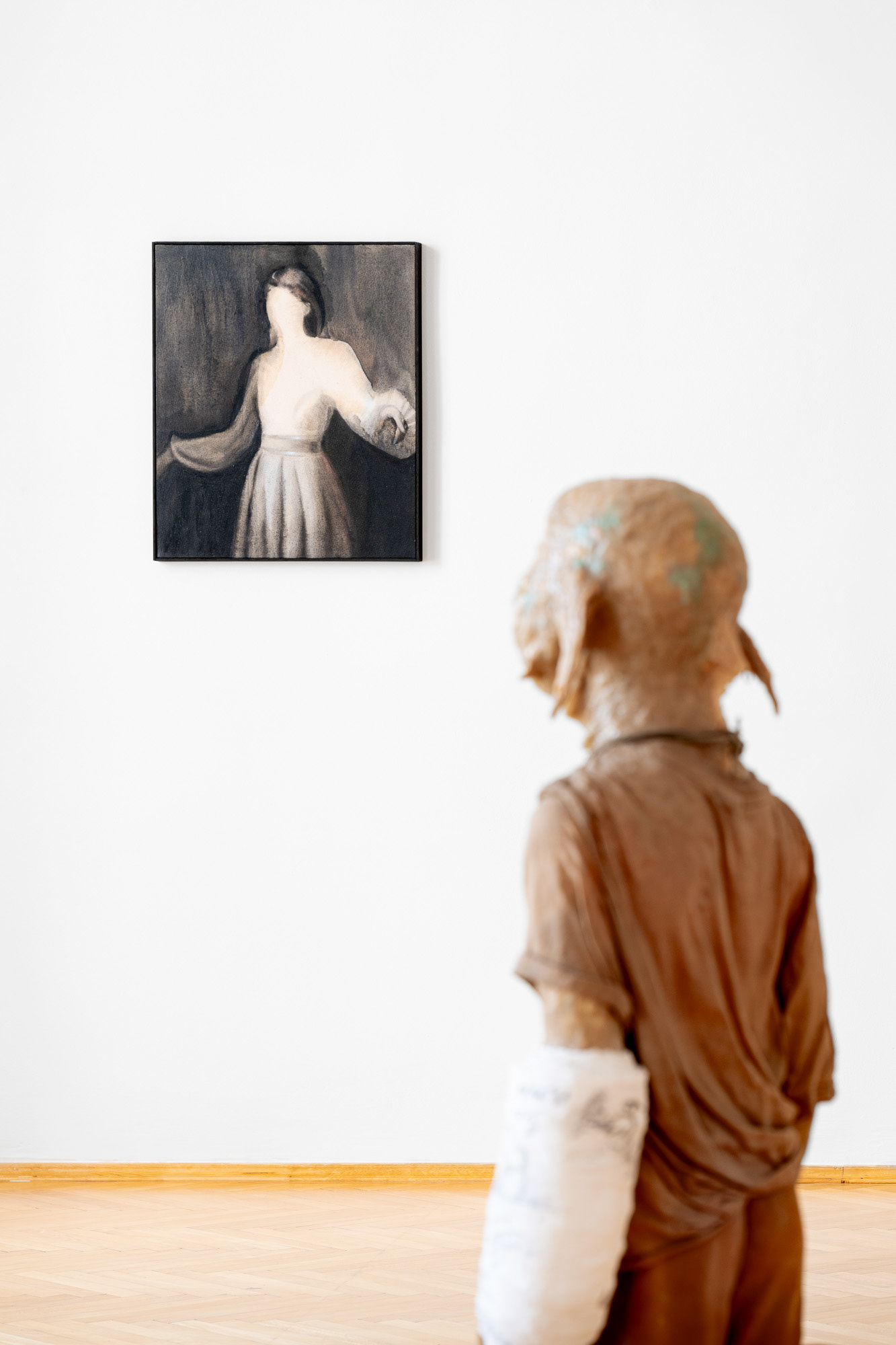
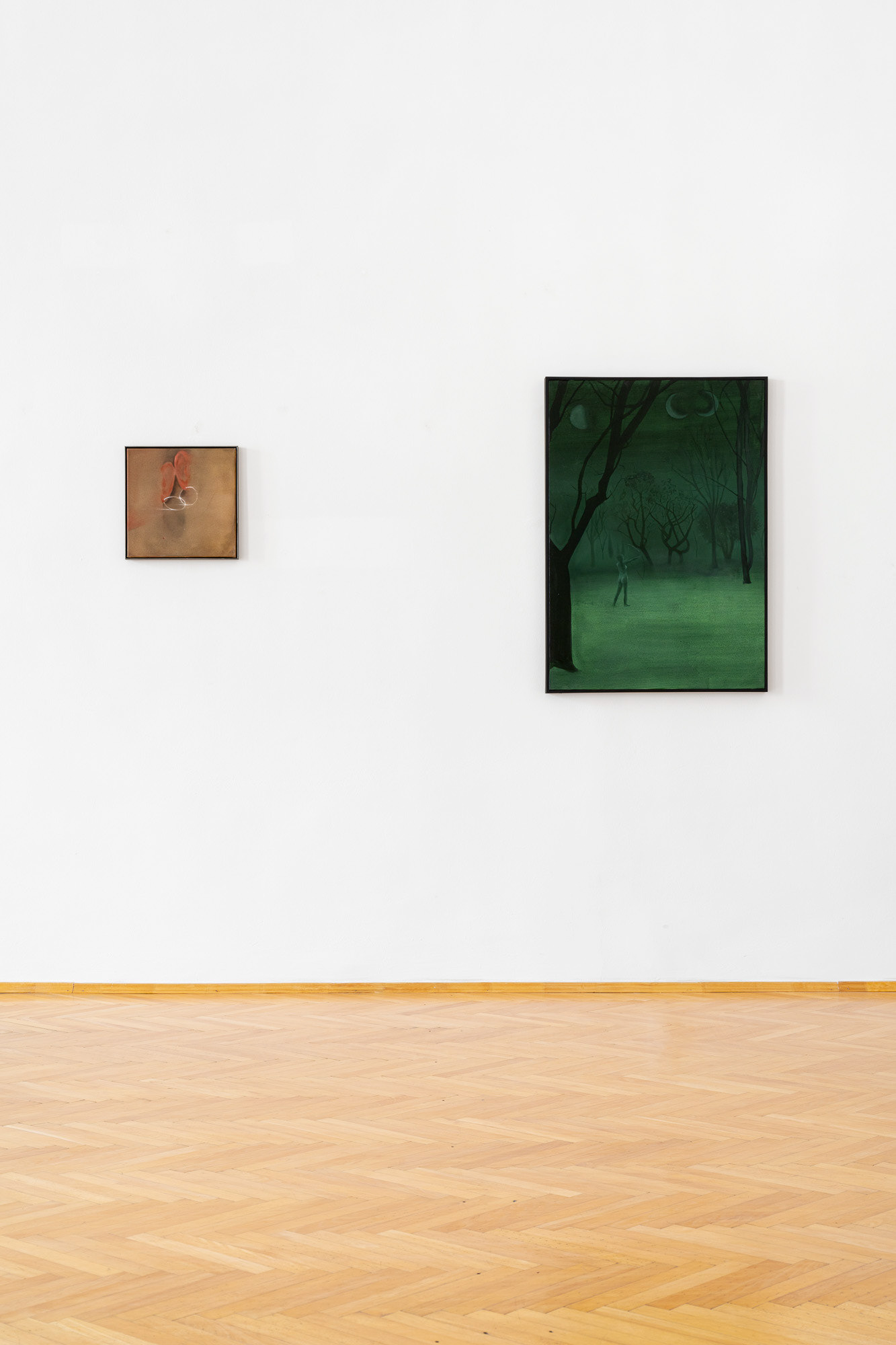
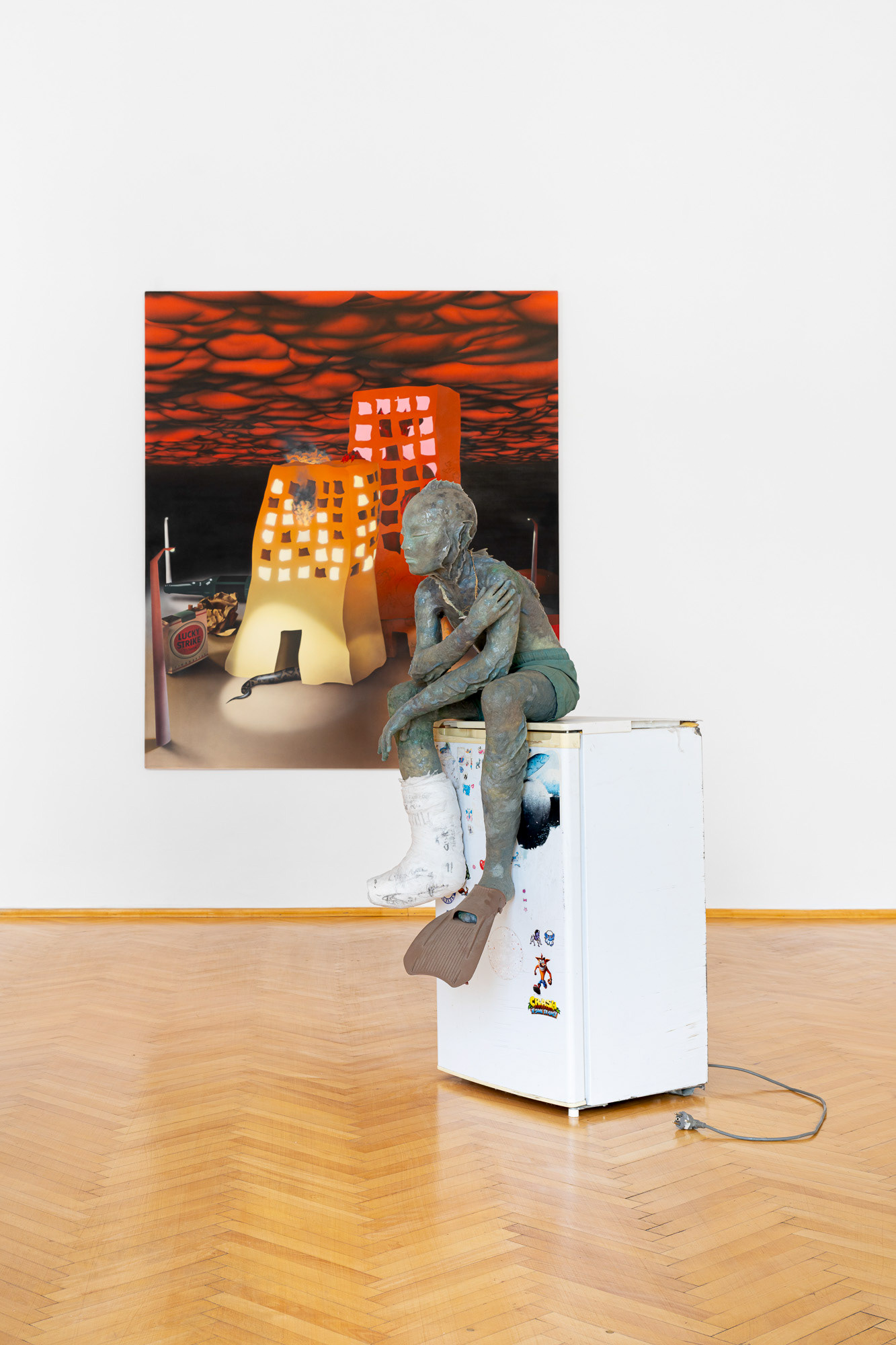
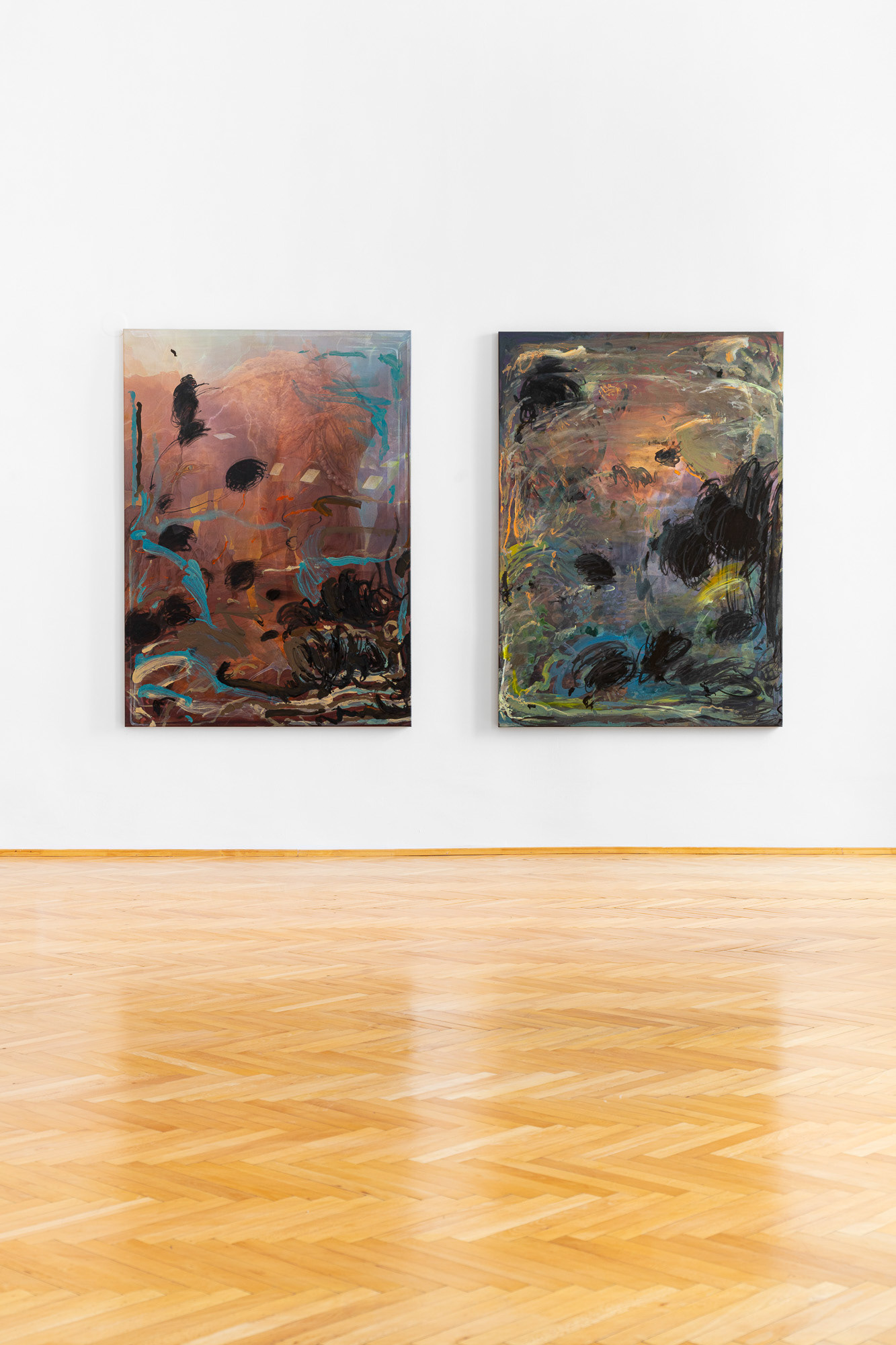
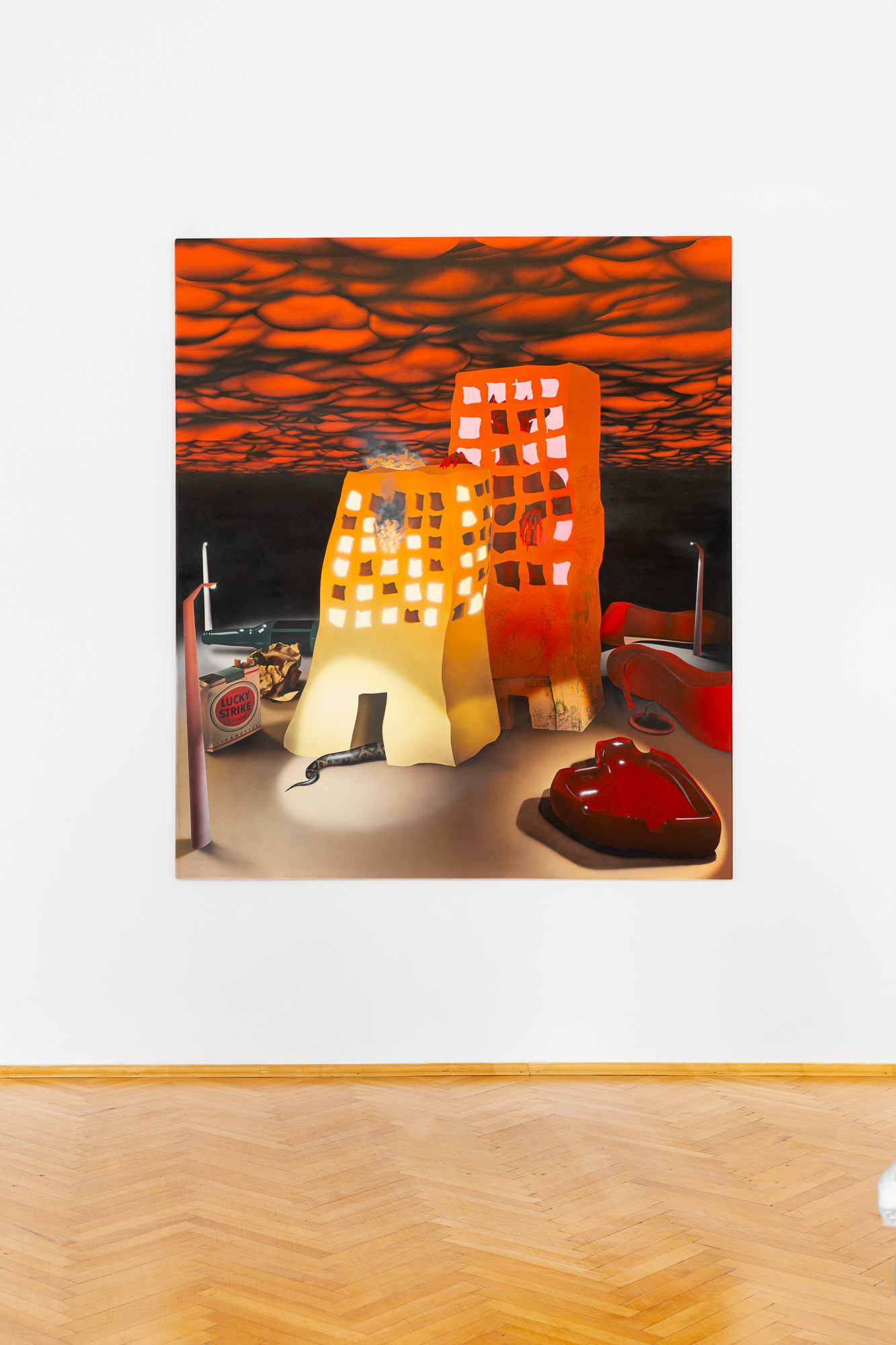
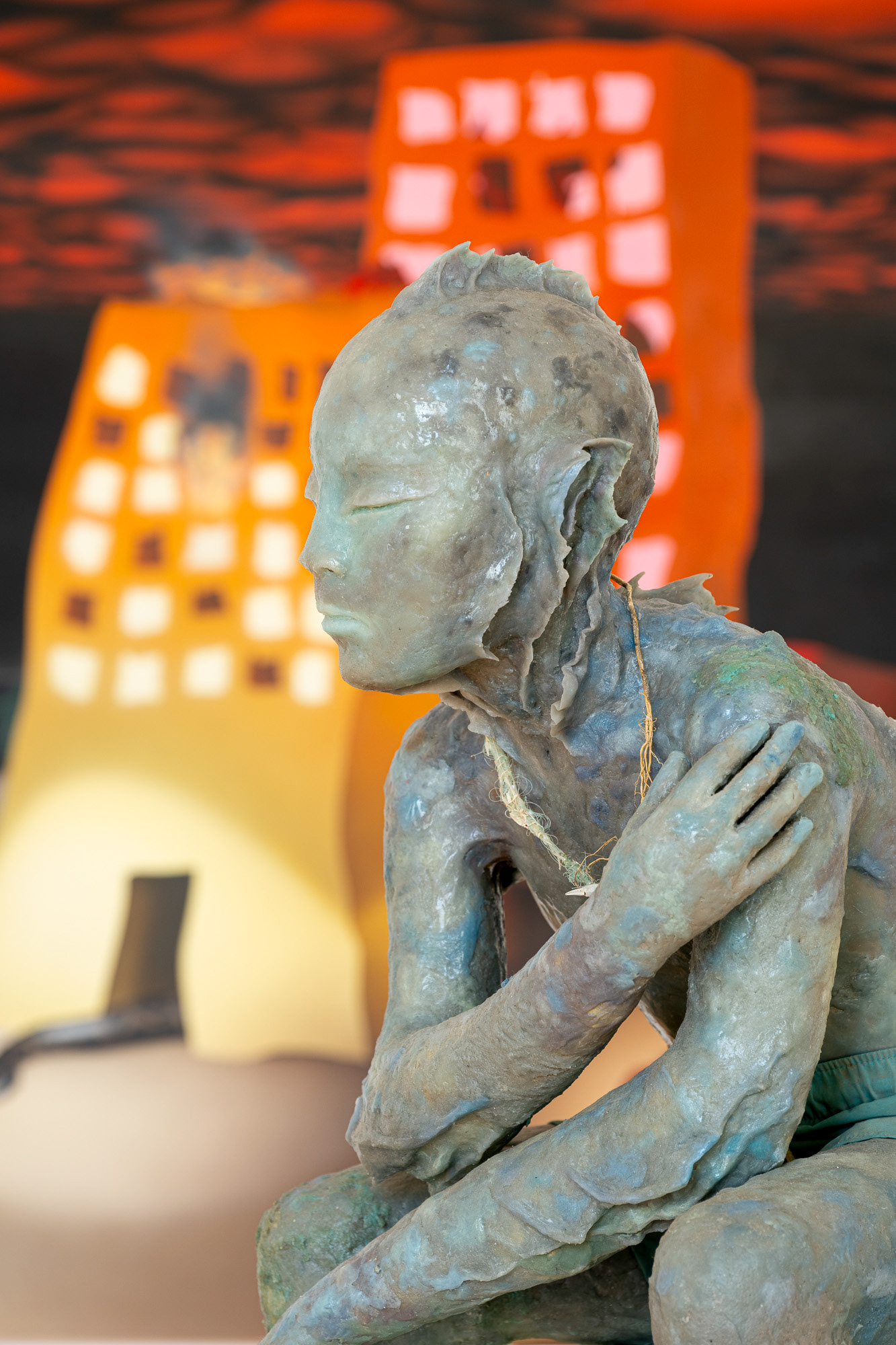
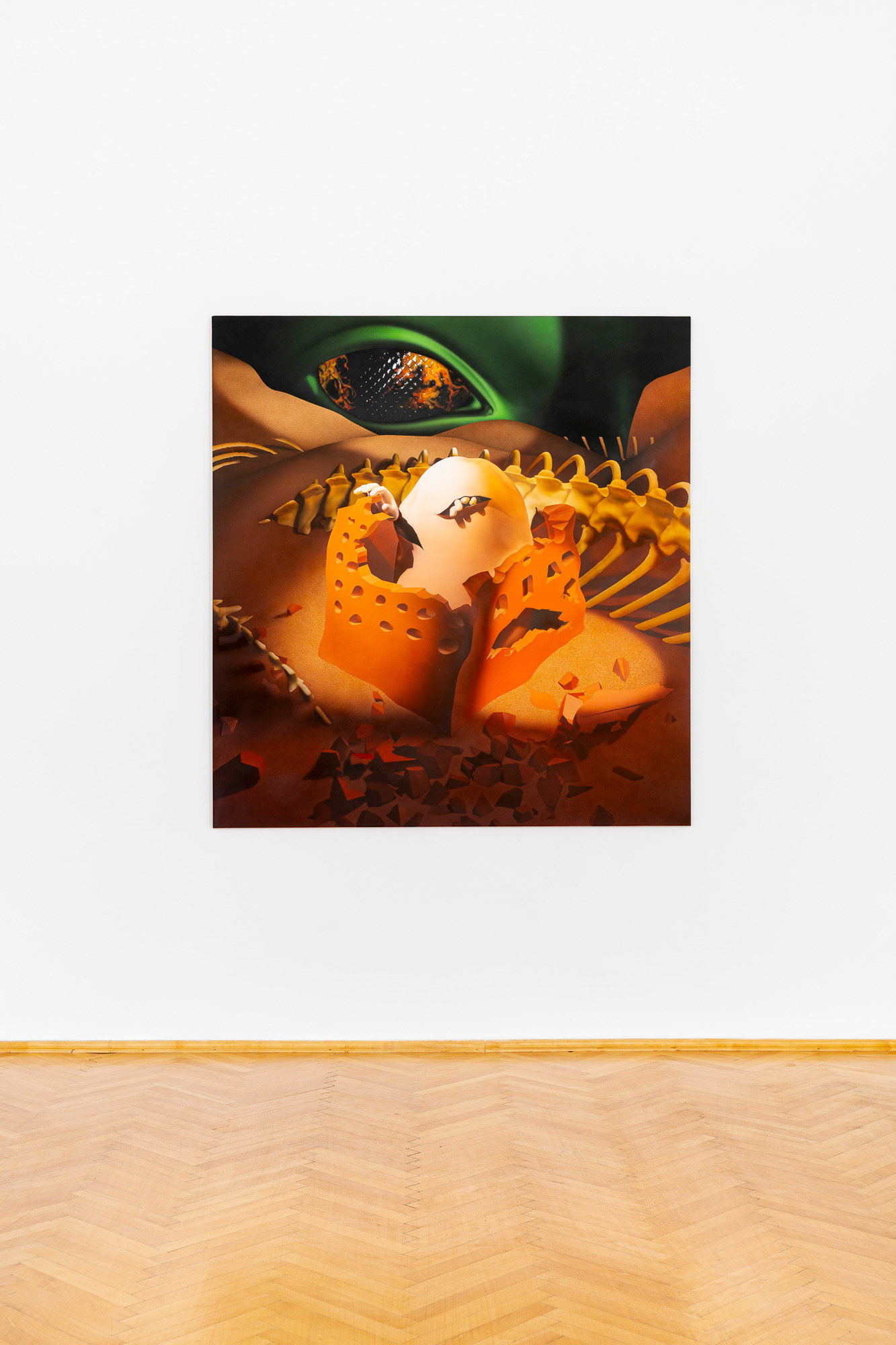
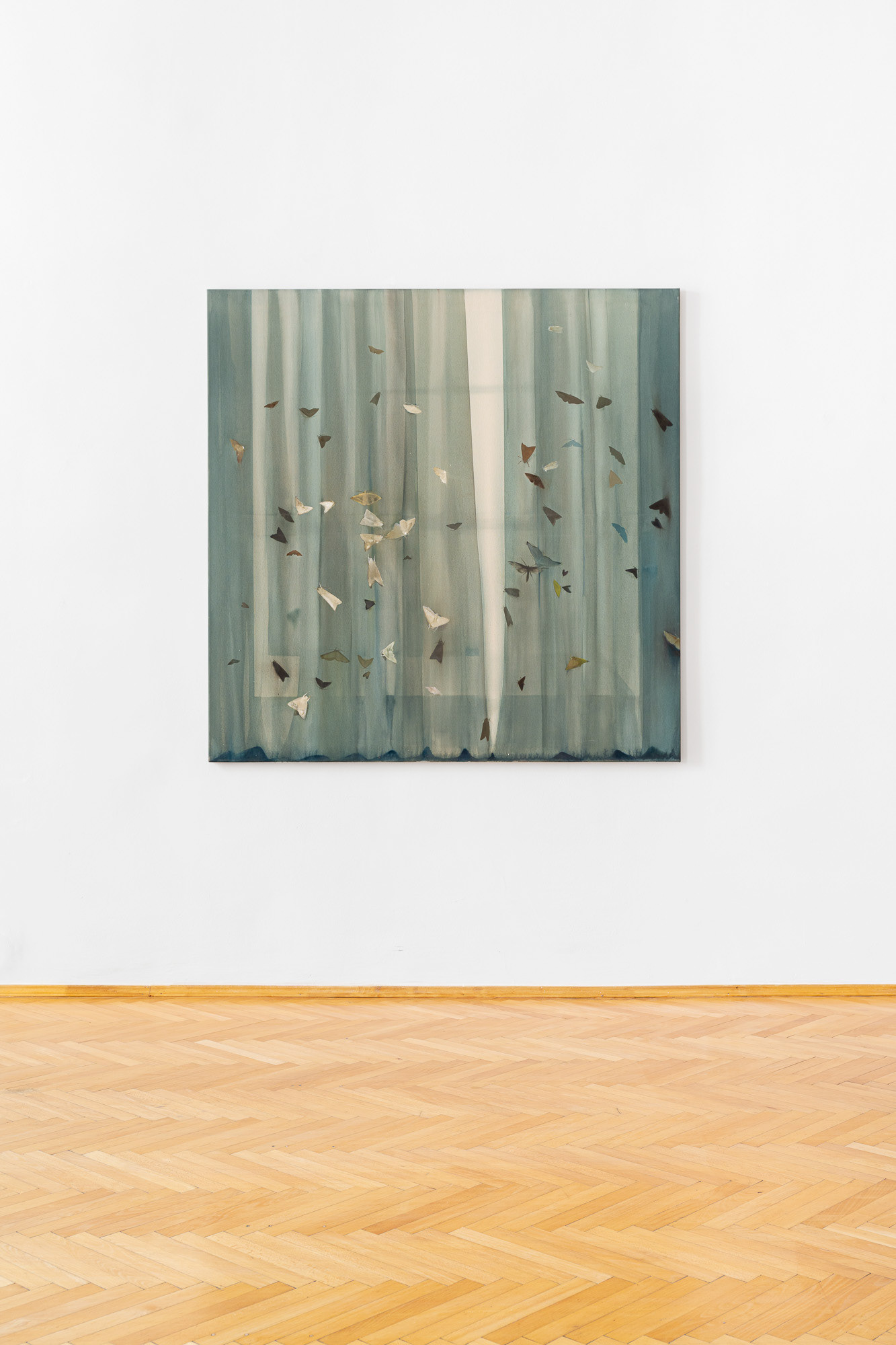
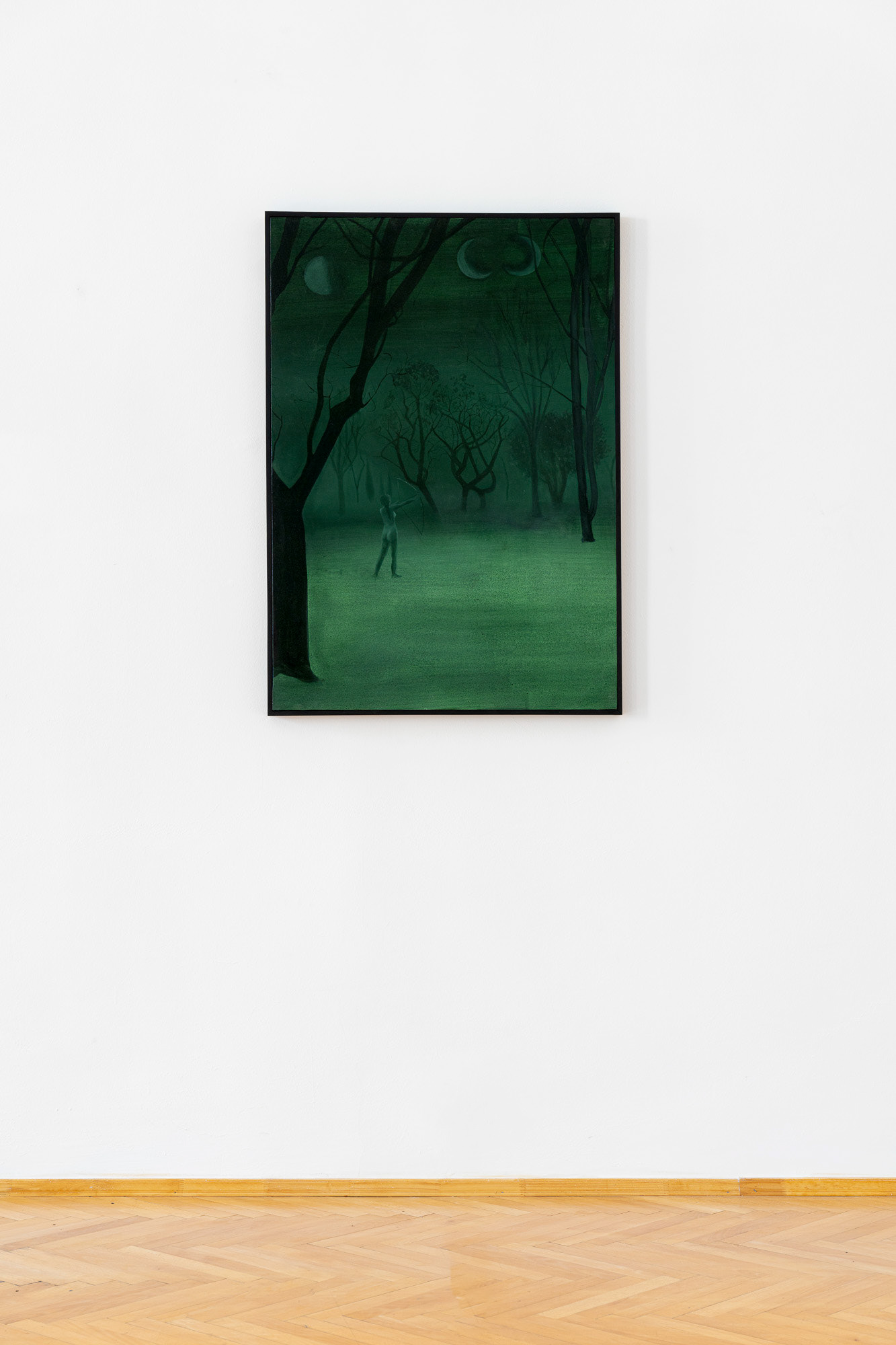
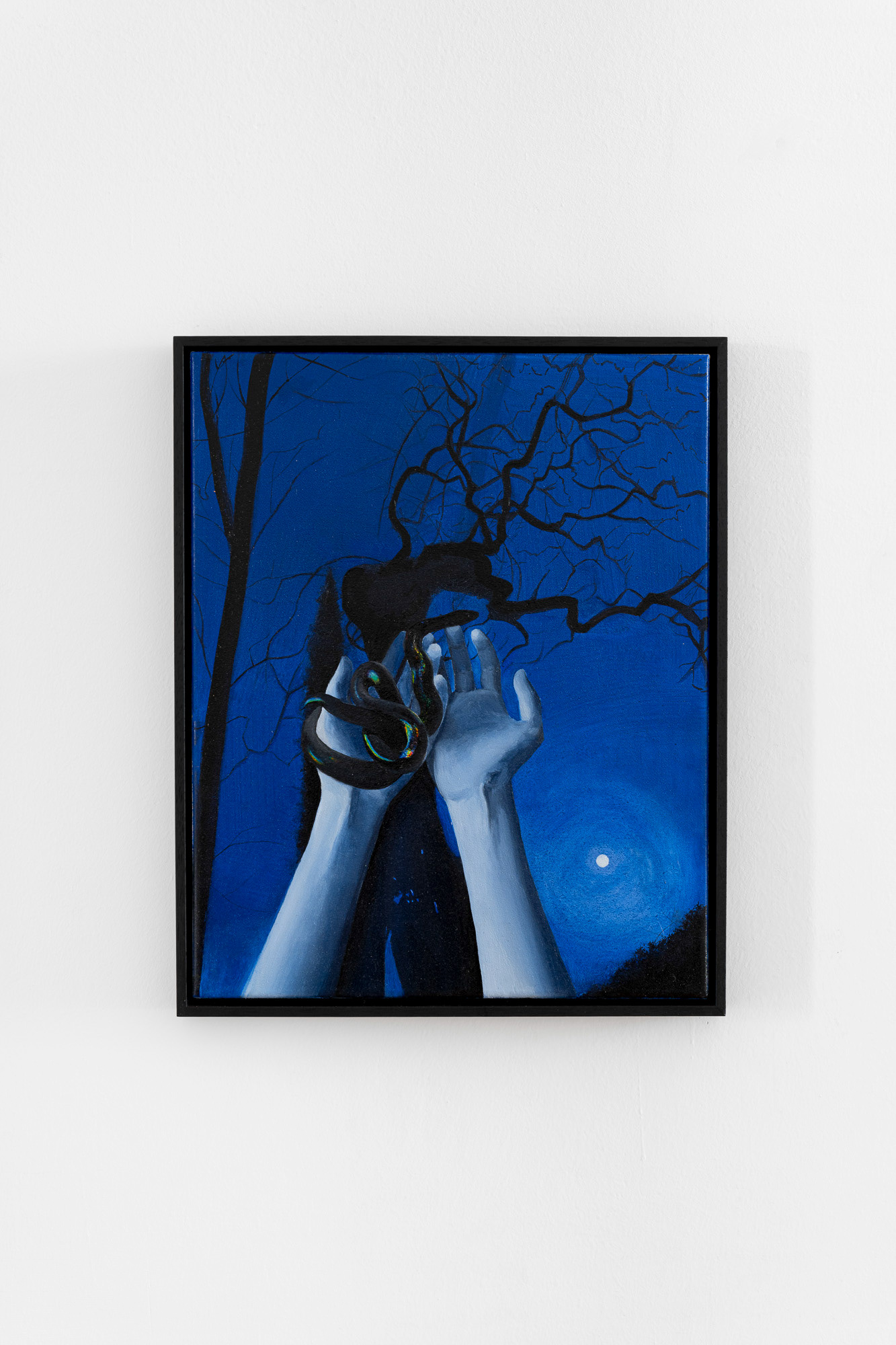
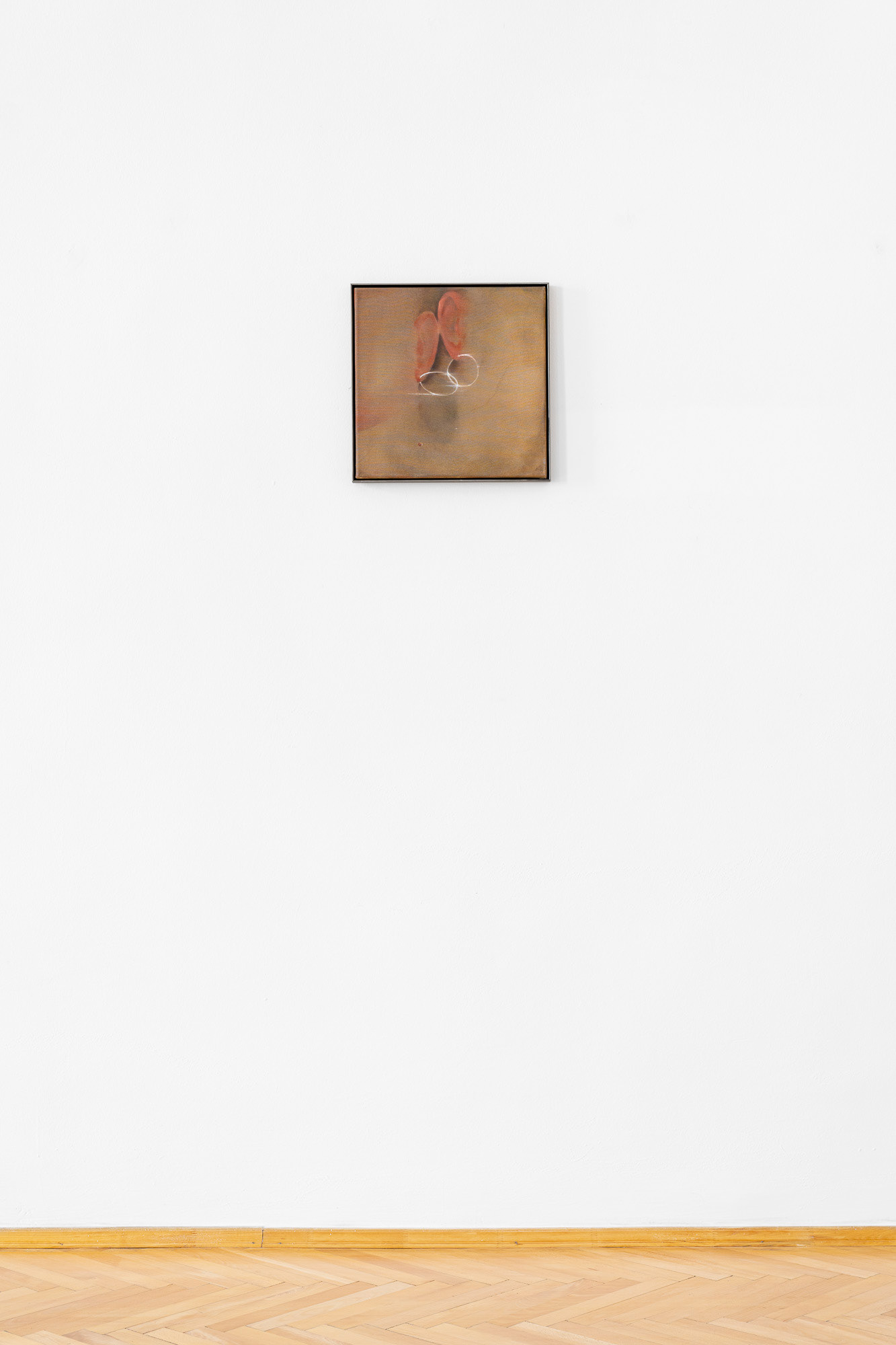
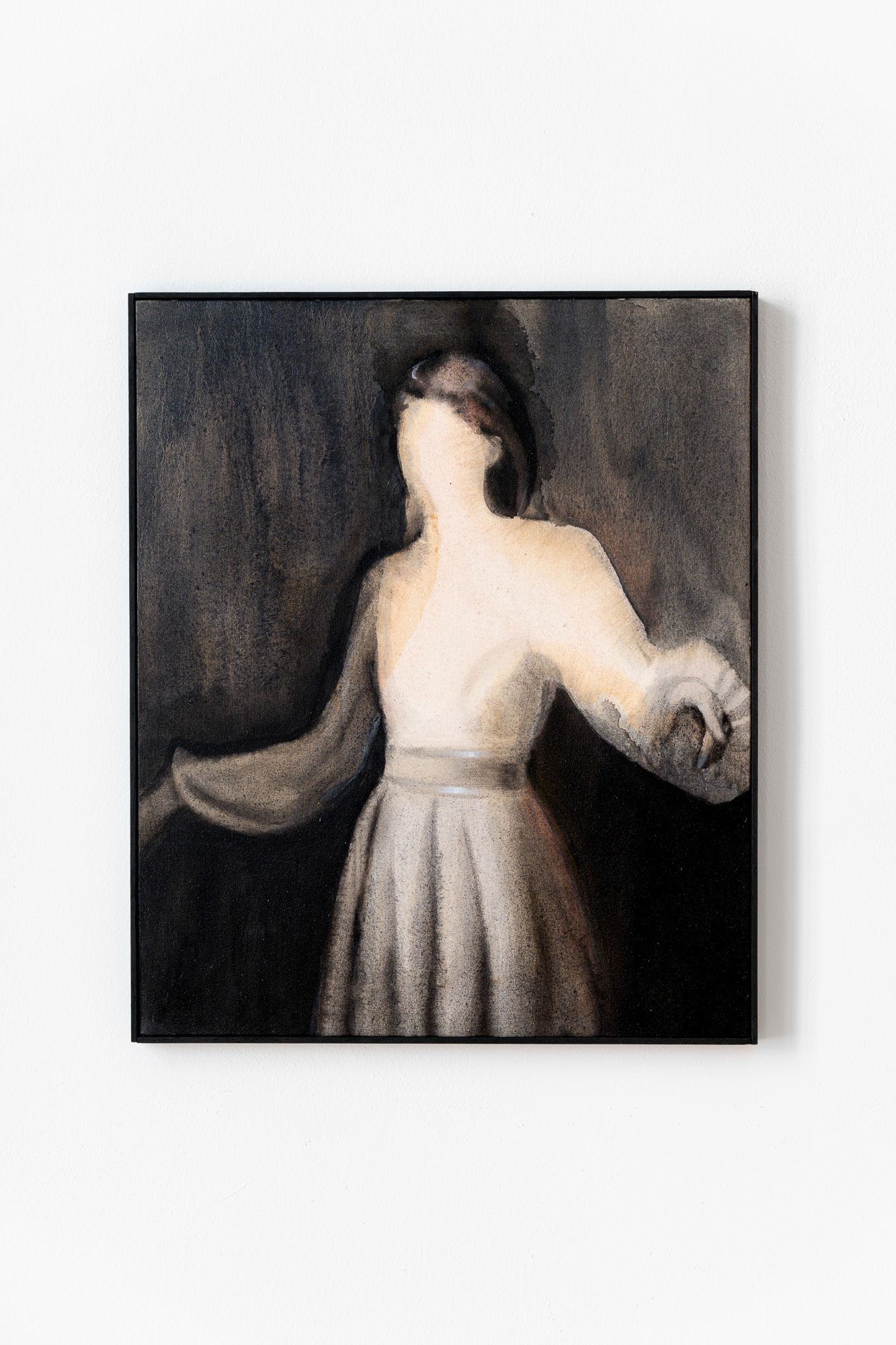
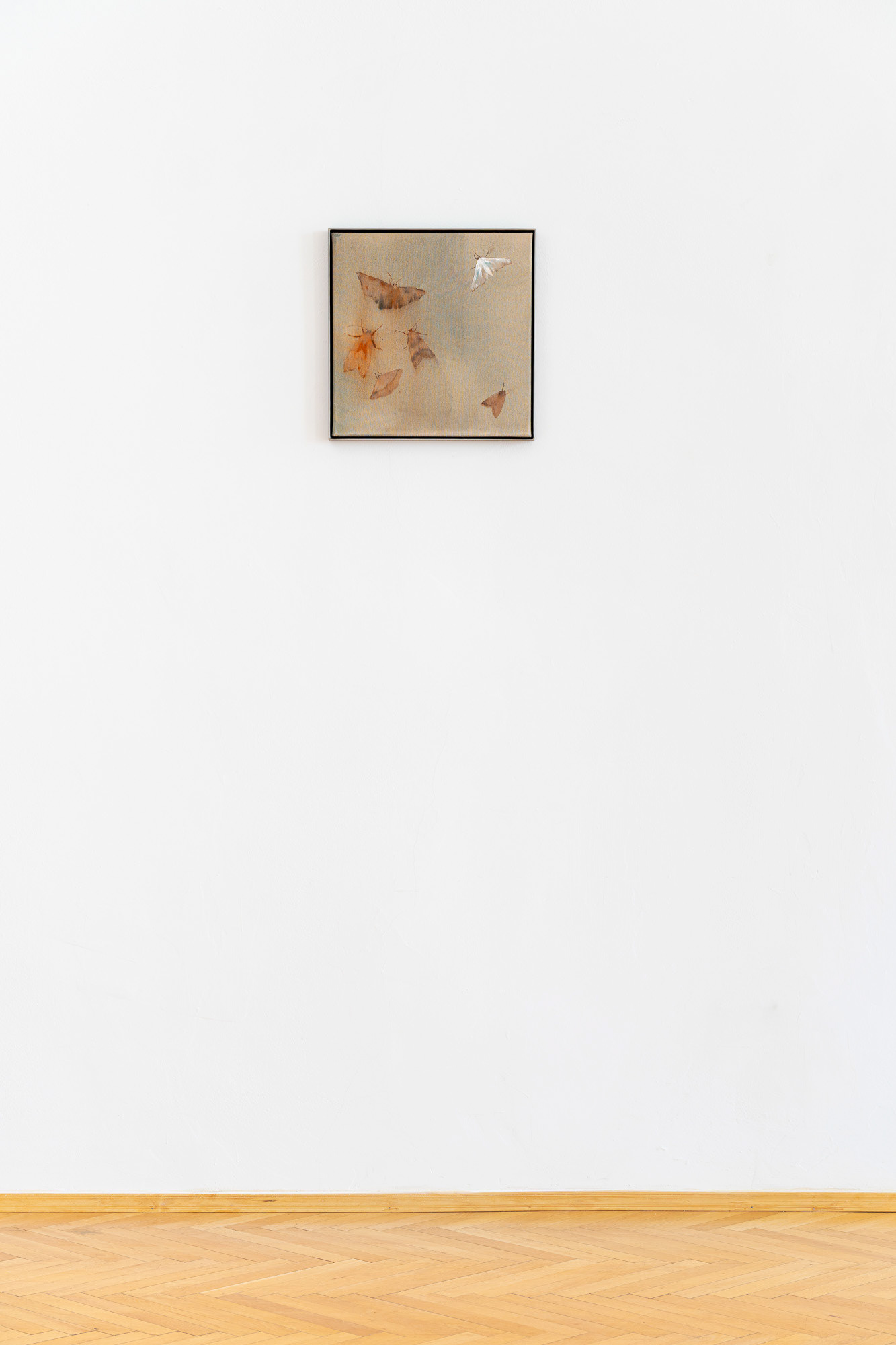
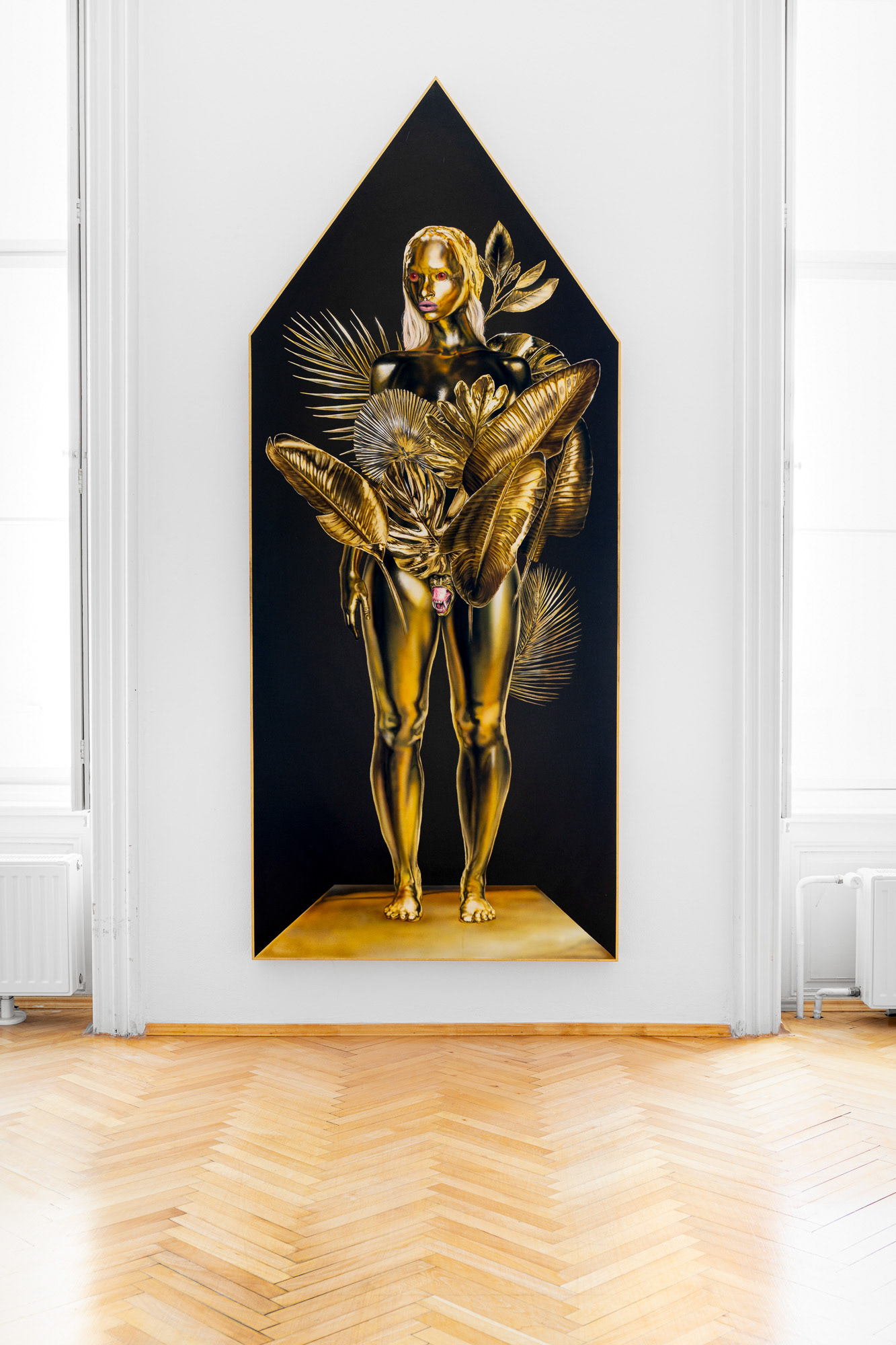
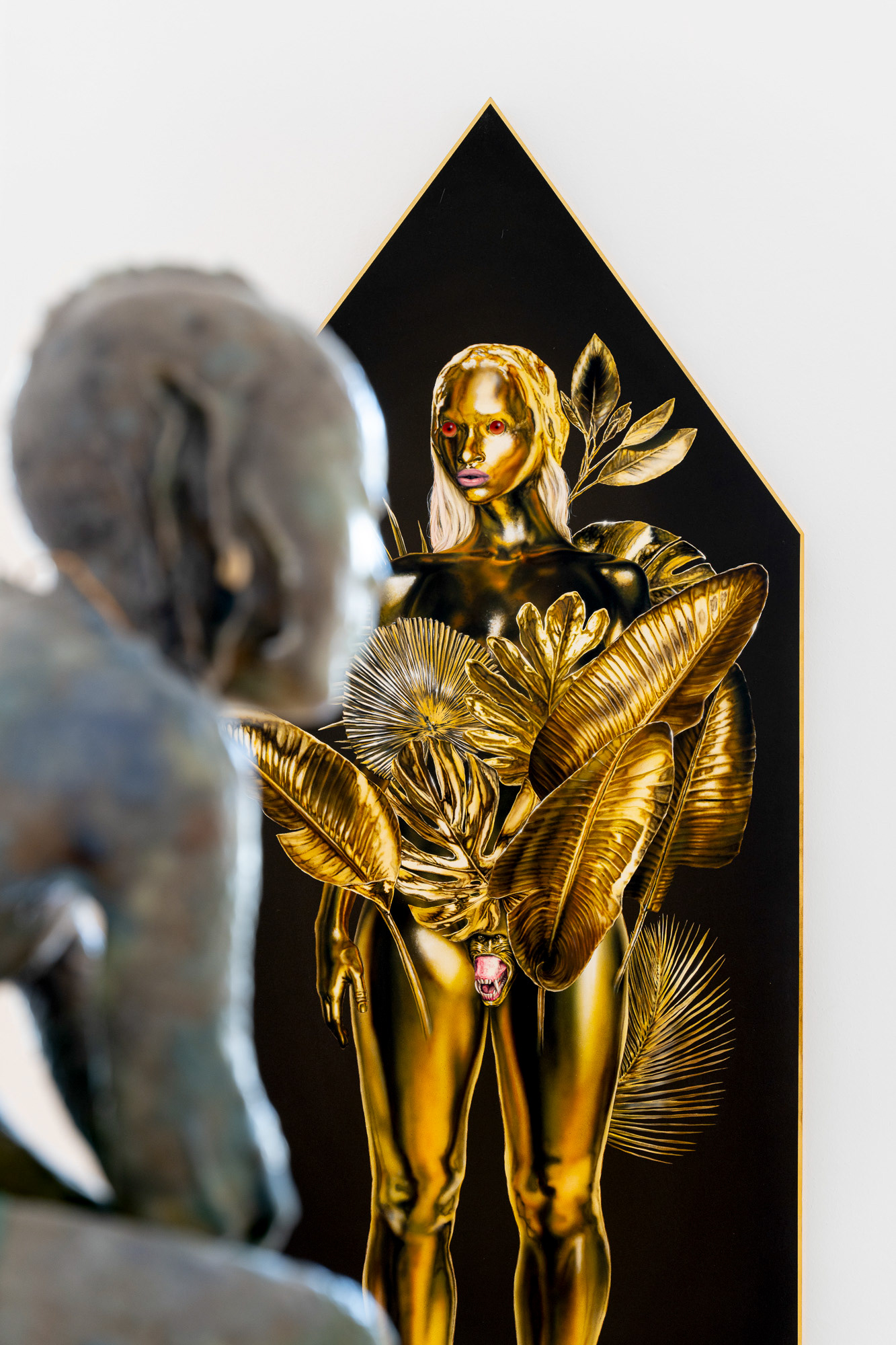
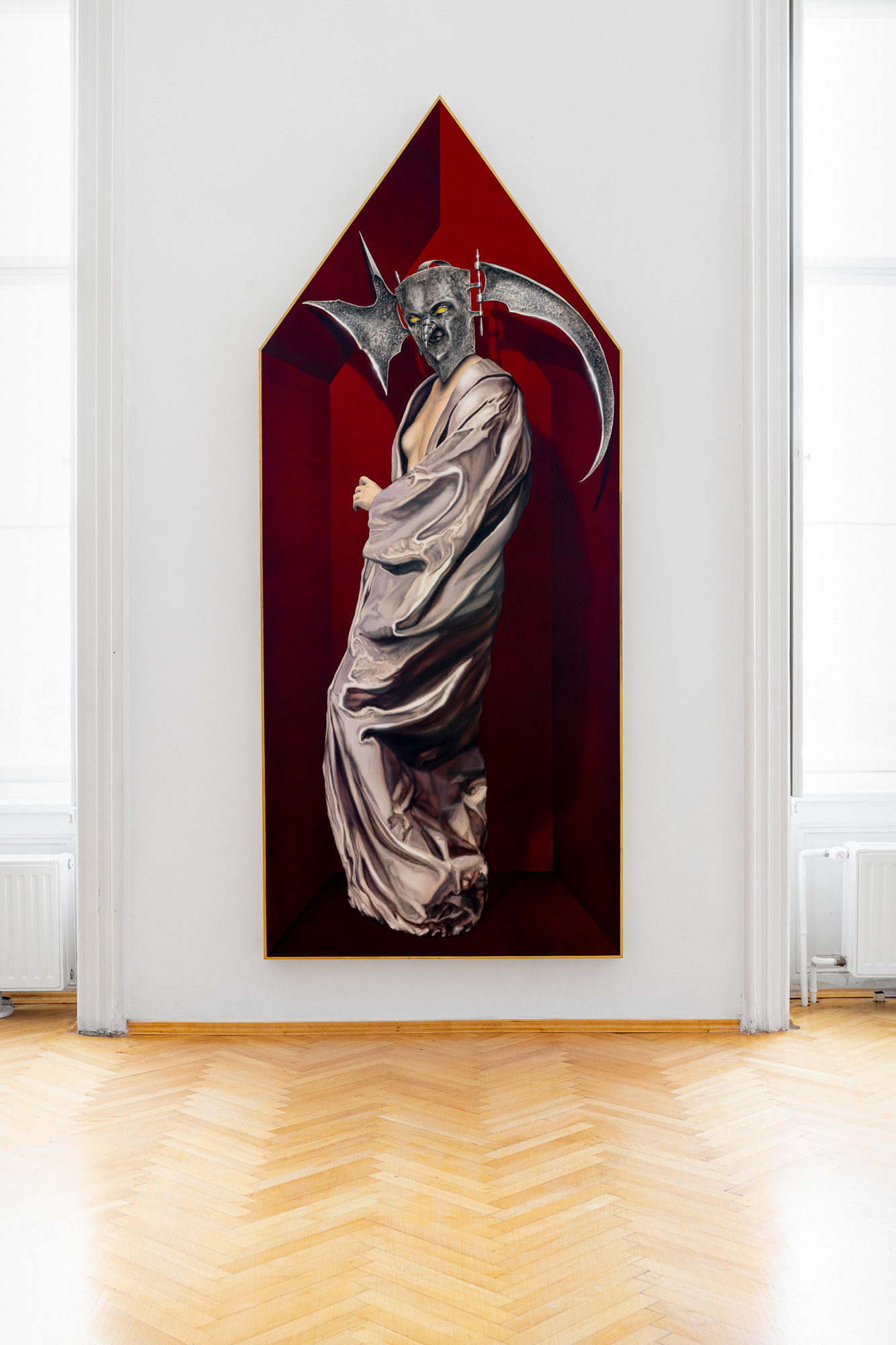
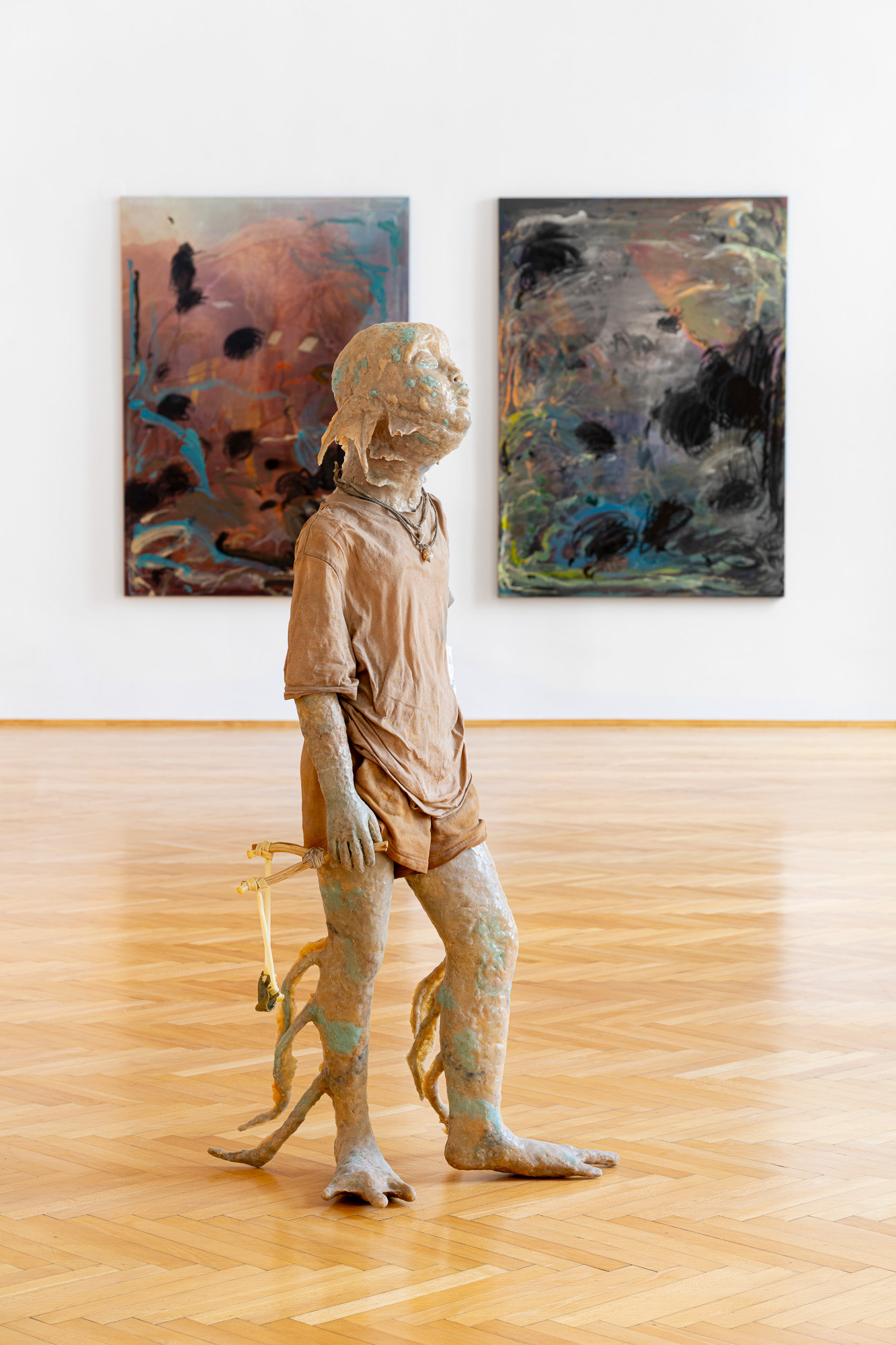
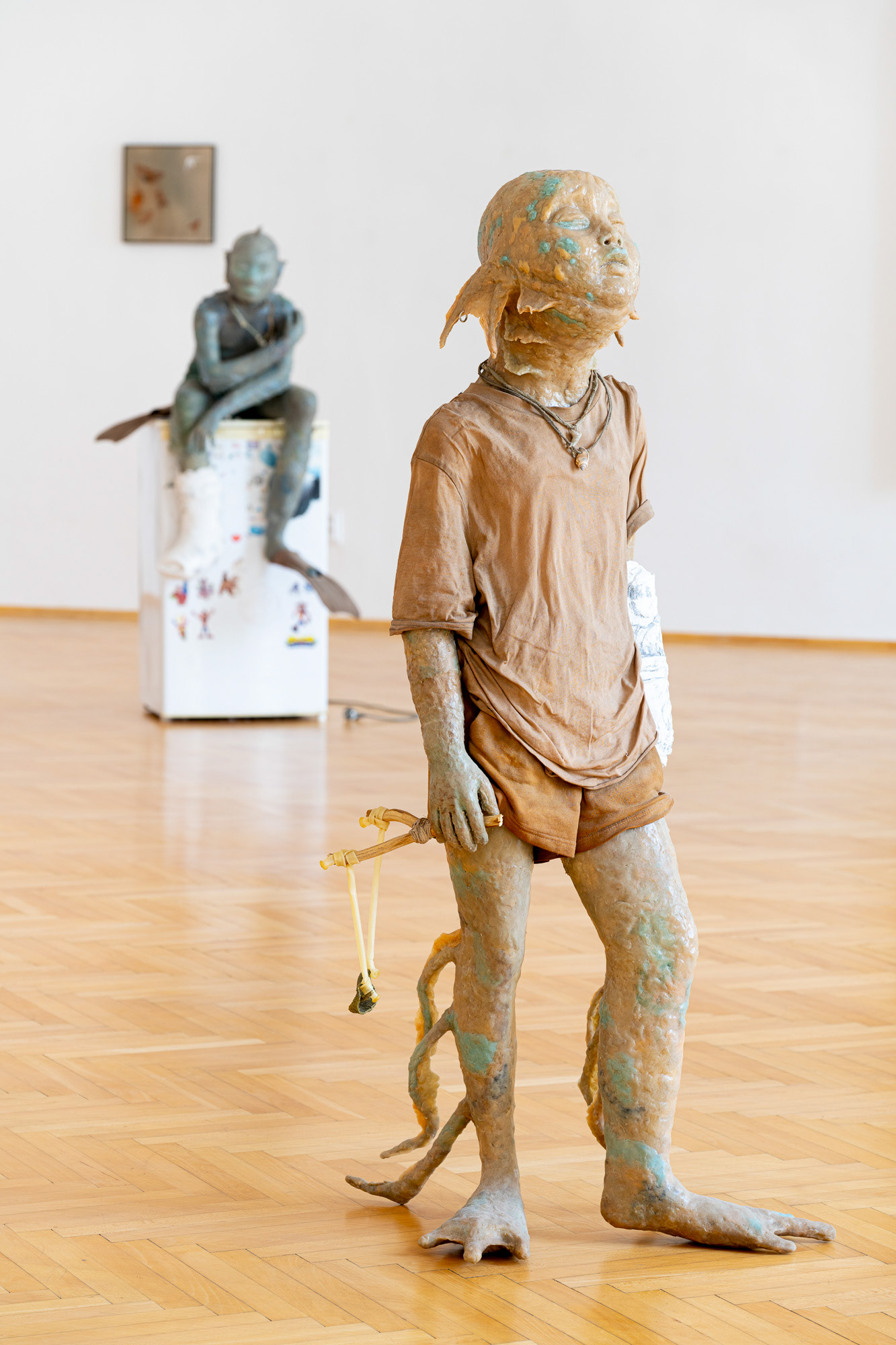
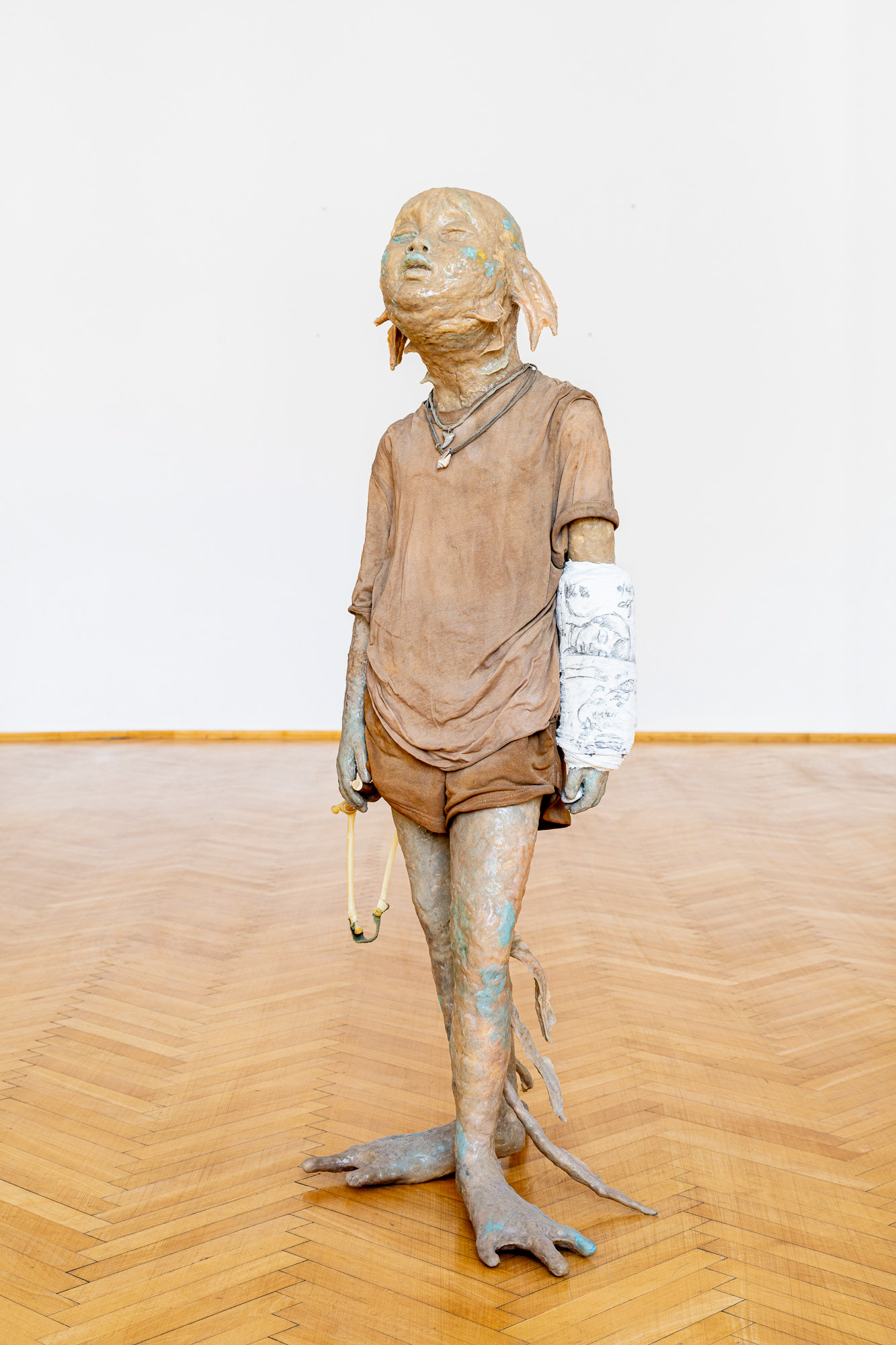
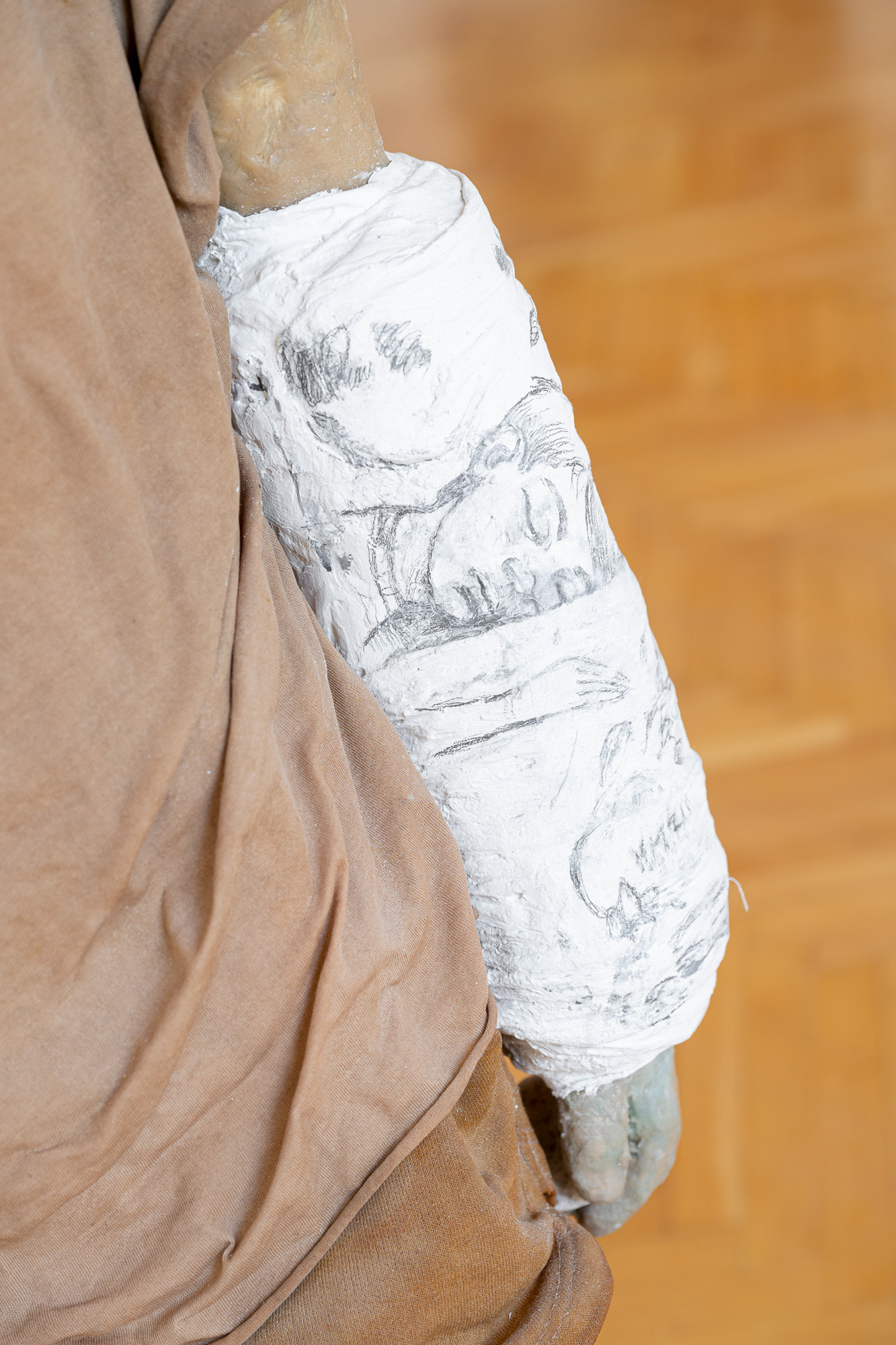
You are in a fragile space-time between night and dawn. The atmosphere is drowsy, slightly daunting. The unsettling feelings from dreams and nightmares continue to loom around. You feel a pressure on your chest, and you can’t move. Both body and mind linger on the threshold of awakening in a state, where the boundary between the inner and outer world remains blurred. The light of the approaching day is a soft hint of a transition from stillness to motion, from darkness to awareness, from dream to reality.
The international group exhibition Fading Moon, Rising Light is a free sequence to the earlier project Full Moon Dreamers (Steinhauser Gallery, 2023). It further explores atmospheres, narratives and a distorted reality rooted in the mystical and surreal realms of night and dreams, focusing on the fragile moment between deep sleep and awakening known as the hypnopompic state. This brief phase, befogging the lines between mental projections and the real world, unfolds in the transition from REM sleep to consciousness. Inner visions dawdle, logic gives way, and the sense of self softens. Unfamiliar voices echo through the space; objects appear eerily familiar and, at the same time, unsettlingly strange. The atmosphere remains quietly charged – as if something happened, yet no one speaks of it.
The exhibition presents a selection of paintings and sculptures by artists from Italy, Hungary and the Czech Republic. Figurative compositions depict a range of human and mythological figures dominating the scene. Some figures are haunting and demonic; others exude a dreamlike romance. Their otherworldly forms and peculiar physical traits invite us into a realm of fantasy and imagination. Interwoven with natural motifs, surreal still-lifes, and abstract gestures, these works cultivate an atmosphere where tranquillity and tension coexist – fleeting moments juxtaposed with strikingly realistic scenes. Through emotionally charged scenes, with lavish symbolism and metaphor, the artists reveal their personal experiences and intimate narratives.
In her intimate oil paintings, Beatrice Alici (b. 1992, Venice; based in Milan) explores the bond between people and nature that appears within night scenes set in undefined historical moments and spaces. Strong heroines rise, enveloped in the mystique of darkness and moonlight, caught in passing moments inspired by folklore and mythology. Through straightforward narratives and thoughtful compositions, Alici crafts a surreal, yet historicising atmosphere that highlights her affinity to psychological depth and symbolism, evoking the sacred and the archetypal feminine.
Dániel Fazekas (b. 1994, Carei; lives in Budapest) creates emotional painting collages driven by surreal principles of composition, personal symbolism, a private library of metaphors, and an introspection onto the world. His vivid acrylic paintings merge digital techniques with traditional painting methods, drawing thematically from childhood memories and personal relationships. He navigates traumas, positive and negative experiences, alongside their psychological echoes – confronting these through his own perception while inviting the viewer into a dialogue with the painting.
Michele Gabriele (b. 1983, Fondi, lives in Milan) creates fragmentary narratives set in an elusive space-time between the past, the future and a parallel present that comes before the apocalypse or lingers after it. In his original line of hyper-realistic figurative sculptures, he connects mythological creatures – Tritons – with sci-fi and pop culture references and museum aesthetics. The figures appear dreamlike, silent and contemplative. We do not know their origin or fate, yet their presence carries the power of an archaeological find from the future. He complements his vision of his own world with a series of abstract paintings in which gestural strokes and minute details transform noise and digital layers into an intuitive discovery of meanings, drawing on the surrealist practice of decalcomania.
Áron Lőrincz (b. 1985, Budapest) explores the realm of sleep paralysis and hallucinations through the lens of mythological demonic beings in his Succubus series. His monumental acrylic paintings on wooden panels – evoking the architecture of chapel interiors – depict figures that are at once sensual and disquieting, marked by hybrid anatomies and physical anomalies. These visually appealing yet haunting forms emerge from the perspective of demonology, appearing within dreams to seduce men and drain them of their life force and soul. Lőrincz probes the delicate boundary between science and mysticism through his work, while also reflecting on the deeply personal experience of intense nocturnal states.
Anna Ruth (b. 1994, Prague) enchants the spectator with ephemeral imagery, fluid gestures, and romanticizing, yet melancholic atmosphere. Her works reflect the relationship between human, nature, and mythological figures amidst them. The works on display explore symbols of fragile moths – symbolising moments of transition, linked with death and introspective dive into emotionally loaded moments. The dreamlike atmosphere evokes nocturnal scenes, yet at the same time feels like a fleeting dream – one that exists outside of reality, somewhere between memory and imagination.
Anna Ruth (b. 1994, Prague) enchants the spectator with ephemeral imagery, fluid gestures, and romanticizing, yet melancholic atmosphere. Her works reflect the relationship between human, nature, and mythological figures amidst them. The works on display explore symbols of fragile moths – symbolising moments of transition, linked with death and introspective dive into emotionally loaded moments. The dreamlike atmosphere evokes nocturnal scenes, yet at the same time feels like a fleeting dream – one that exists outside of reality, somewhere between memory and imagination.
Si v krehkom časopriestore medzi nocou a úsvitom. Atmosféra je ospalá a mierne skľučujúca. Znepokojujúce pocity zo snov a nočných môr ešte celkom nevyprchali. Cítiš tlak na hrudi a nevieš sa pohnúť. Telo i myseľ sú na prahu prebúdzania, v stave, v ktorom je hranica medzi vnútorným a vonkajším svetom stále nejasná. Svetlo prichádzajúceho dňa jemne naznačuje prechod z pokoja do pohybu, z temnoty do vedomia, zo sna do reality.
Medzinárodná skupinová výstava Fading Moon, Rising Light voľne nadväzuje na projekt Full Moon Dreamers (Steinhauser Gallery, 2023) a pokračuje v skúmaní atmosféry, naratívov a skreslenej skutočnosti ukotvených mystickým a surreálnym kontextom noci a snov. Sústredí sa na krehký moment medzi hlbokým spánkom a prebúdzaním, ktorý je známy aj ako hypnopompický stav. Krátka fáza stierajúca hranice medzi mentálnymi projekciami a skutočným svetom vzniká pri prechode z REM fázy spánku do bdenia. Vnútorné výjavy pretrvávajú, logika ustupuje a vnímanie vlastného bytia sa rozostruje. V priestore sa ozývajú neznáme hlasy, objekty pôsobia povedome a zároveň znepokojivo cudzo. Atmosféra zostáva príznačne tichá – akoby sa niečo stalo, no nikto o tom nehovorí.
Výstavný projekt predstavuje výber z maliarskej a sochárskej tvorby autoriek a autorov žijúcich v Taliansku, Maďarsku a Česku a dominujú mu figurálne kompozície zobrazujúce rôzne ľudské a mytologické postavy. Niektoré pôsobia desivo démonicky, ostatné zas zasneno romanticky. Ich nadprirodzený vzhľad a podivné fyzikálne vlastnosti nás presúvajú do prostredia fantázie a imaginácie. V kombinácii s prírodnými motívmi, surrealistickými zátišiami či abstrahujúcimi gestami vytvárajú prostredie, v ktorom vládne pokoj i napätie – efemérne momenty kontrastujú s výraznými realistickými situáciami. Prostredníctvom emocionálnych výjavov pretkaných symbolizmom a metaforami autorky a autori prinášajú svoje osobné skúsenosti a intímne príbehy.
V intímnych olejomaľbách Beatrice Alici (1992, Benátky, žije v Miláne) sledujeme spojenie ľudí s prírodou, ktoré sa odohráva v nočných scenériách existujúcich v nekonkrétnych historických obdobiach a priestoroch. Silné hrdinky obklopené mystikou tmy a mesačného svitu nachádzame v efemérnych situáciách inšpirovaných folklórom a mytológiou. Alici jednoduchými naratívmi a kompozičnými riešeniami vytvára surreálnu a zároveň historizujúcu atmosféru, ktorou zdôrazňuje príklon k psychologizácii, prácu so symbolikou a odkazuje na sféru posvätného a archetypálneho ženského princípu.
Dániel Fazekas (1994, Carei, žije v Budapešti) vytvára emocionálne maliarske koláže poháňané surrealistickými kompozičnými princípmi, osobnou symbolikou, vlastnou knižnicou metafor a introspektívnym pohľadom na svet. Vo výrazných akrylových maľbách spája digitálne technológie s tradičnými maliarskymi postupmi, pričom tematicky vychádza zo spomienok na detstvo a z osobných vzťahov. Pracuje s traumami, pozitívnymi aj negatívnymi skúsenosťami a pridruženými psychologickými procesmi, ktoré konfrontuje s vlastnými prežívaním a zároveň ich ponúka ako platformu na dialóg medzi obrazom a divákom.
Michele Gabriele (1983, Fondi, žije v Miláne) vytvára fragmentárne naratívy zasadené do neuchopiteľného časopriestoru – medzi minulosťou, budúcnosťou a paralelnou prítomnosťou, ktorá prichádza pred apokalypsou alebo po nej už len doznieva. V originálnej línii hyperrealistických figurálnych sôch prepája mytologické bytosti – Tritónov so sci-fi či popkultúrnymi referenciami a muzeálnou estetikou. Postavy pôsobia snovo, ticho a kontemplatívne. Nepoznáme ich pôvod ani osud, no ich prítomnosť nesie silu archeologického nálezu z budúcnosti. Víziu vlastného sveta dopĺňa maliarskou sériou abstraktne pôsobiacich obrazov, v ktorých gestické ťahy a drobné detaily premieňajú šum a záznamy digitálnych vrstiev na intuitívne objavovanie významov, nadväzujúc na surrealistické praktiky dekalkománie.
Áron Lőrincz (1985, Budapešť) sa v sérii Succubus zaoberá spánkovou paralýzou a halucináciami cez prizmu mytologických démonických bytostí. Na monumentálnych akrylových maľbách na drevených paneloch pripomínajúcich architektúru kaplniek zobrazuje zmyselné, no zároveň desivé figúry s hybridnou anatómiou a fyzickými anomáliami. Vizuálne fascinujúce, no zároveň stále hrozivé postavy sa z pohľadu démonológie objavujú v snoch, aby zvádzali mužov s cieľom vysať z nich životnú energiu a dušu. Lőrincz otvára otázky hranice medzi vedou a mystikou a zároveň reflektuje individuálne prežívanie intenzívnych nočných stavov.
Diela Anny Ruth (1994, Praha) okúzľujú podmanivou zmesou mixom efemérnych výjavov, ľahkosťou maliarskeho gesta a romantizujúco-melancholickými tendenciami, ktoré sledujú prepojenie človeka, prírody a všetkých mytologických bytostí medzi nimi. Vystavené diela pracujú so symbolikou krehkých nočných molí, ktoré symbolizujú momenty transformácie, sú spojené so smrťou aj s introspektívnym ponorom do emocionálne nabitých okamihov. Zasnená atmosféra malieb evokuje nočné situácie, no zároveň pôsobí ako prchavý sen existujúci mimo realitu, kdesi medzi spomienkou a fantáziou.
